How Fast Can a Rubik's Cube Be Solved
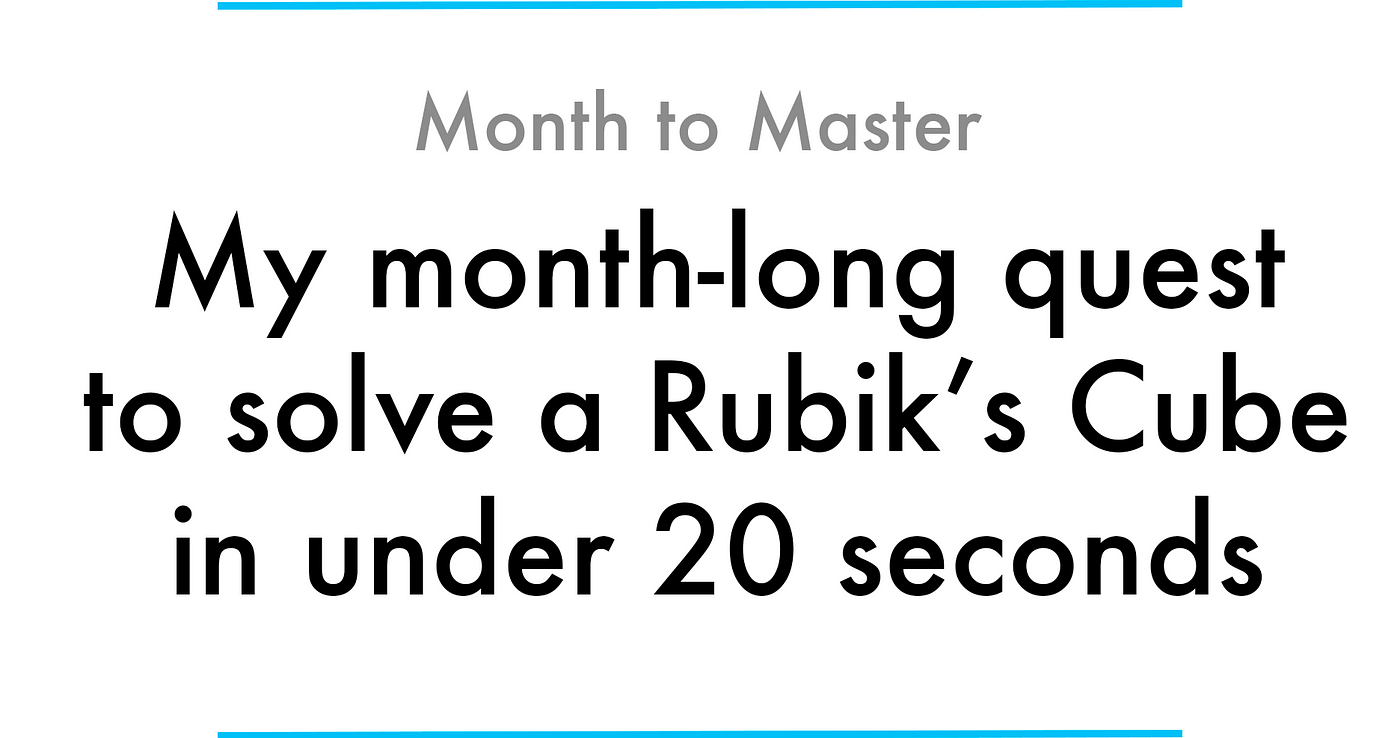
On January 1, 2017, I asked myself the question: Within one month of practice, can I solve a Rubik's Cube in under 20 seconds?
On January 24, 2017, after 25 hours of practice, I constitute out that the answer was aye.
During the calendar month of January, I documented my entire learning process in a series of 31 daily blog posts, which are compiled here into a single narrative. In this article, you can relive my month of insights, frustrations, learning hacks, and triumphs, as I strive towards monthly mastery.

It's January 1st today, which ways it's time to commencement a new claiming. This month, my goal is to solve a Rubik's Cube in under 20 seconds.
Why 20 seconds?
2 months agone, at San Francisco's Ferry Building, I went to a book consequence and signing by Ian Scheffler, the writer of Cracking the Cube, the predominant book on speed cubing (the competitive sport of solving the Rubik's Cube).
At the result, I spoke with the author and the dozens of Bay Expanse speed cubers that attended. I wanted to learn about the major benchmarks in the sport.
Repeatedly, what I heard was "The well-nigh significant criterion in speed cubing is the 20-2nd mark. Breaking xx seconds is similar breaking the 4 minute mile".
At first, I just thought that the equivalence was symbolic, but, that day, I also heard that "If you look at the proportion of cubers who can solve "sub-20" to all cubers (i.e. people who ain a Rubik'southward Cube), it's about equivalent to the proportion of runners who can run sub-iv miles out of all competitive runners".
I'thou not exactly sure how this was computed, or exactly how accurate it is. But, nevertheless, it's clear that 20 seconds is the most notable criterion in speed cubing.
Thus, I've set up my sights on a sub-20 fourth dimension.
My starting betoken
I actually have a long history with the Rubik's Cube: I originally learned how to solve it when I was in Middle School, and, always since, I've been casually solving information technology for fun.
All the same, I've never really tried to become fast. Instead, I prefer the more than meditative, tactile approach of smoothly solving the cube.
In fact, I oasis't actually timed myself in eight or 9 years. So, to properly boot off this month, I set up a camera and a computer-based timer, and completed five solves at height speed.
The average of the five solves was 48.29. (44.46, 51.83,46.15, 53.62, 45.41).
This isn't horrible nor is it cracking. However, if you have no Rubik'southward Cube experience, it's possible to call up that I'm non too far abroad from a sub-20 time.
But, to continue the running analogy, solving a Rubik'south Cube in 48.29 is symbolically equivalent to running a 7-minute mile. In other words, it's a reasonably respectable fourth dimension for an amateur, just it's far from a competitive time for a serious athlete.
A month of deliberate practice
Over the past 9 years, I've solved the Rubik's Cube hundreds of times, but never with the goal of improving. Equally a result, my time has simply improved by around x seconds from 60-ish seconds to fifty-ish seconds.
This month, I'm taking a more deliberate arroyo with my practice, explicitly looking to shave another 30 seconds off my time.
My hope is that my endeavor this month reveals the overwhelming difference betwixt 9 years of mindless practice and 30 days of deliberate practice.
Fourth dimension to formulate my plan of attack…

Over the next few days, I'll be experimenting with a number of training techniques and exercises, to make up one's mind the all-time 30-day Rubik'southward Cube preparation programme. In particular, the program needs to get my Rubik's Cube solving speed consistently under 20 seconds.
To understand my training program and the rest of this calendar month's posts, it's important that y'all first empathize the method I use to solve a Rubik's Cube, which is called CFOP.
Intro to CFOP
CFOP is the near mutual speed cubing method and is the one that I originally learned.
CFOP stands for 1. Cross, 2. F2L, 3. OLL, 4. PLL, which are the four steps used, in this method, to solve the cube. These acronyms probably don't mean much, so permit me become through each ane.
1. Cross
With a fully scrambled cube, I outset by finding the white eye, which identifies the white side of a solved cube.
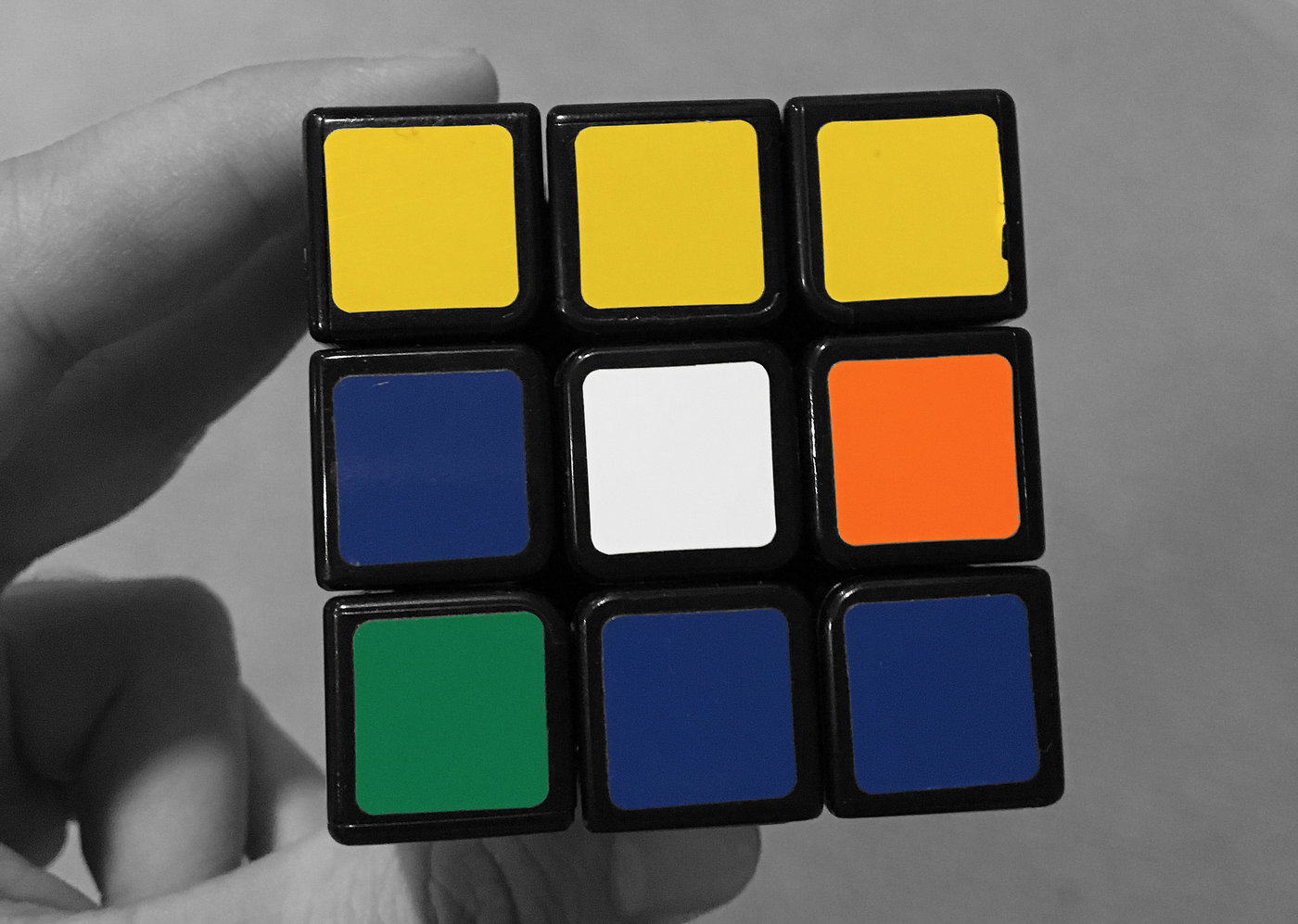
I then find the white edge pieces, and movement them into place, so that a white cantankerous is formed on the white side.
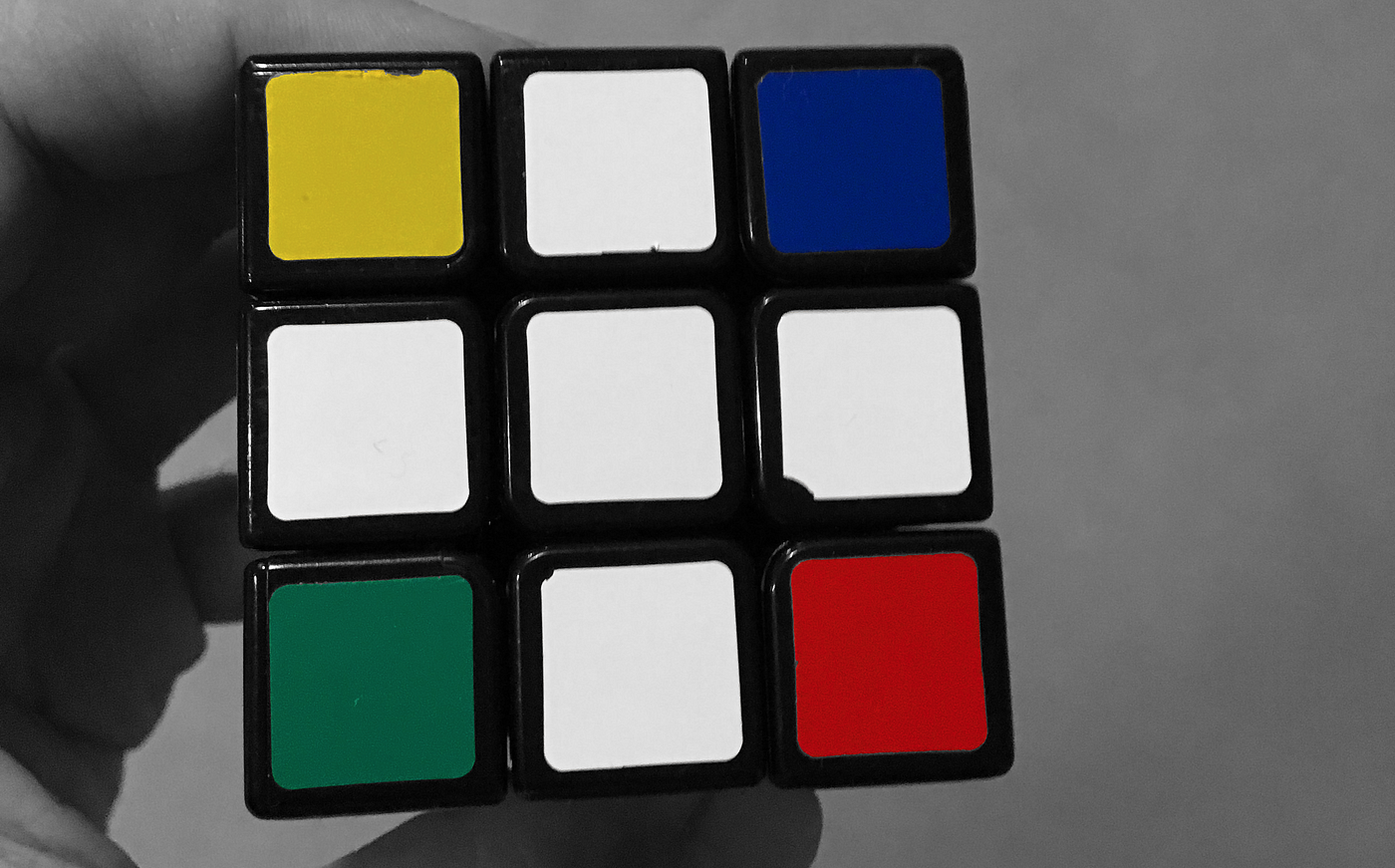
It'southward of import that the border pieces not merely friction match up with the white center, merely that they also match upward with the right color of the adjacent centers.
For instance, the white and green border slice should exist placed between the white center and the greenish center. The white and red edge piece should be placed between the white center and the red heart. And then on.

The cross is complete.
ii. F2L (Outset ii Layers)
Once the cross is formed, I put the white side of the cube on the lesser, which looks like this.
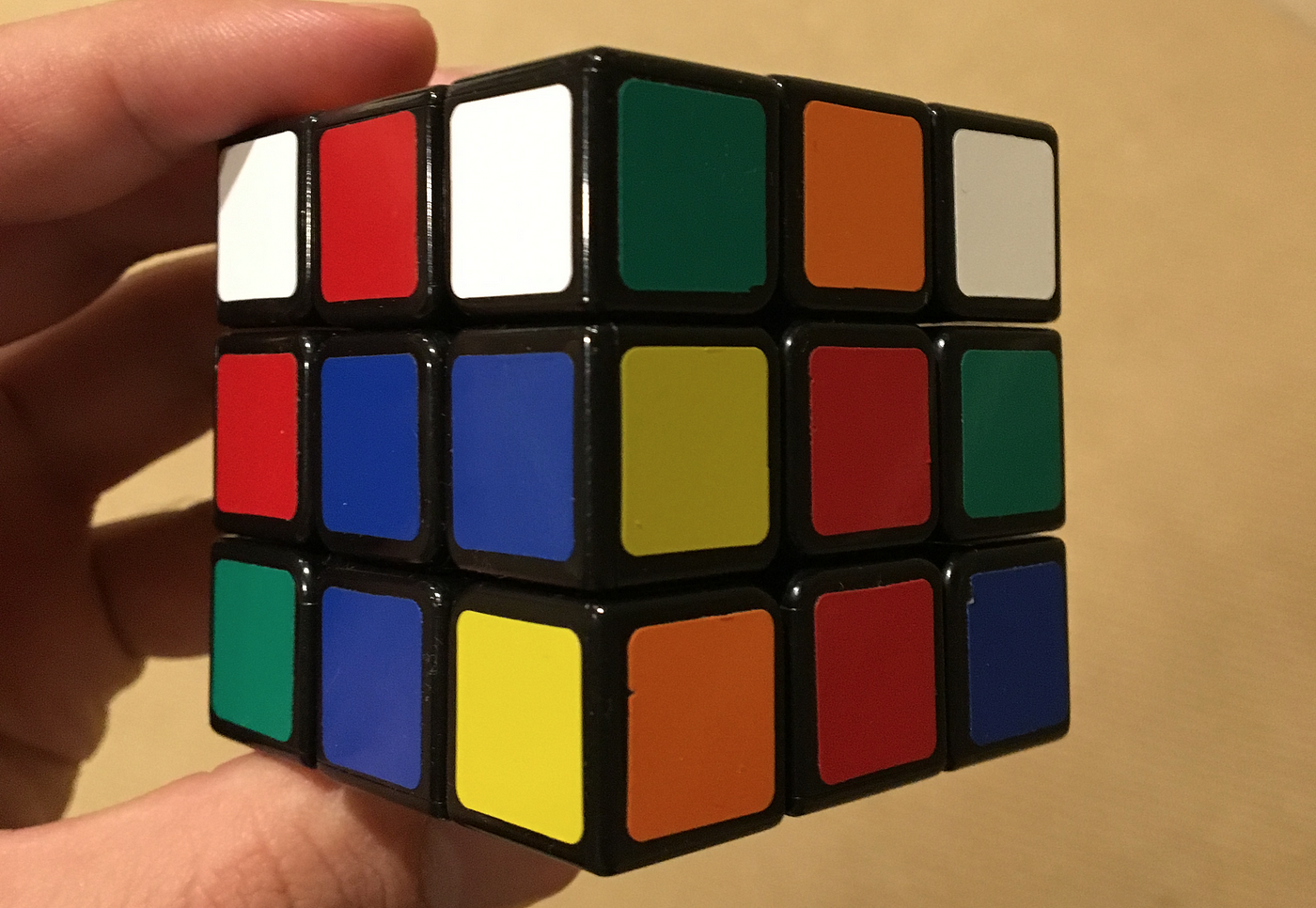
In this next step, F2L, or 'First 2 Layers', I'one thousand focused on solving the showtime two layers of the cube, starting from the lesser.
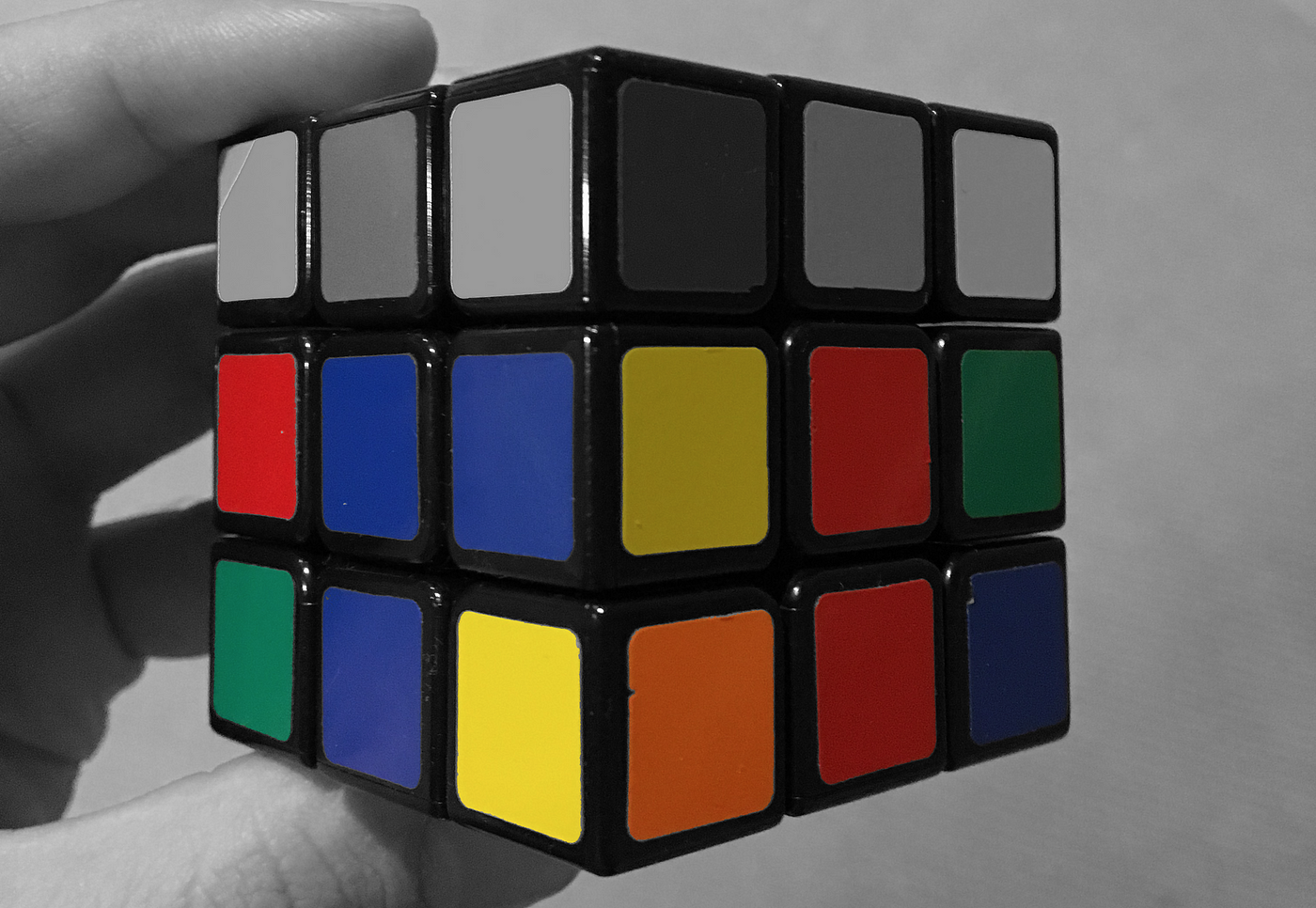
Since the eye pieces and 'white + color' border pieces are already solved (from the terminal step), I just need to focus on solving the highlighted areas below.
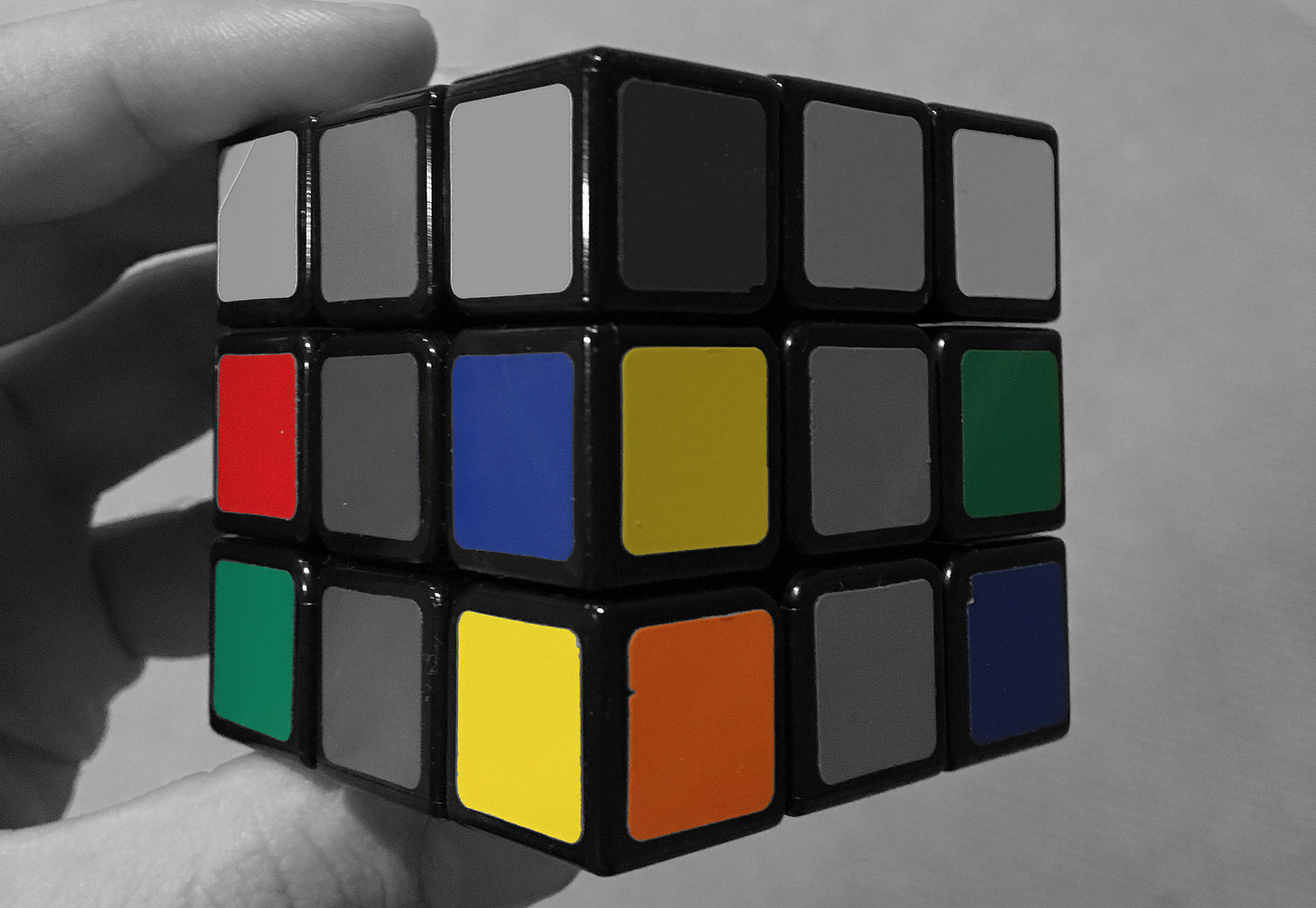
Afterwards placing the correct pieces in these slots, the cube looks like this.
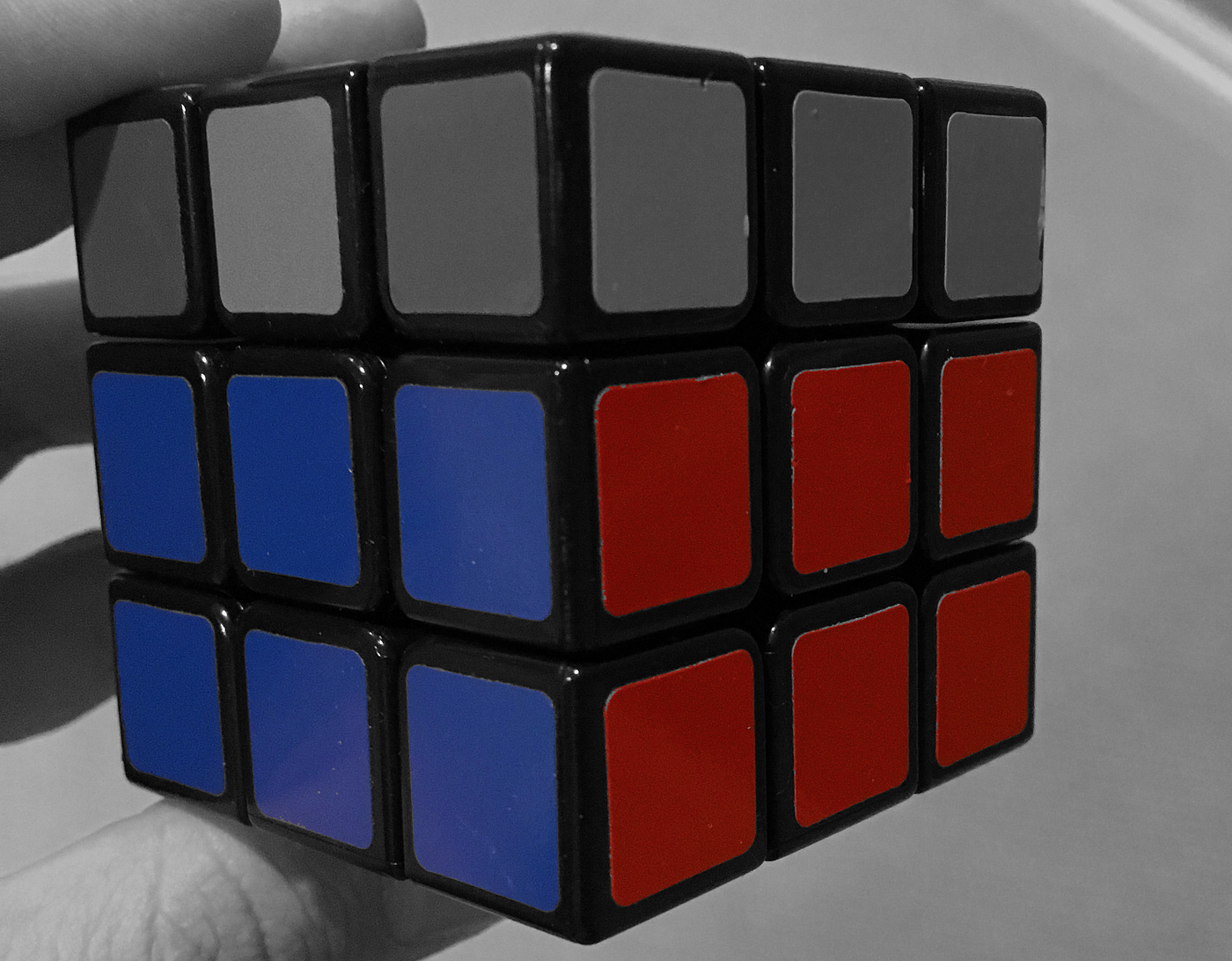
Here, in the solved land, it's easier to visualize which pieces I moved during F2L: I positioned the four border pieces (like the blue and ruby-red edge piece) between the corresponding centers (similar the blueish middle and the red center). I besides positioned the four corner pieces that accept a white side and 2 other colored sides (similar the white, blue, and ruddy corner piece) in the right slot on the bottom layer.
As a event, when I end F2L, the white side is completely solved.
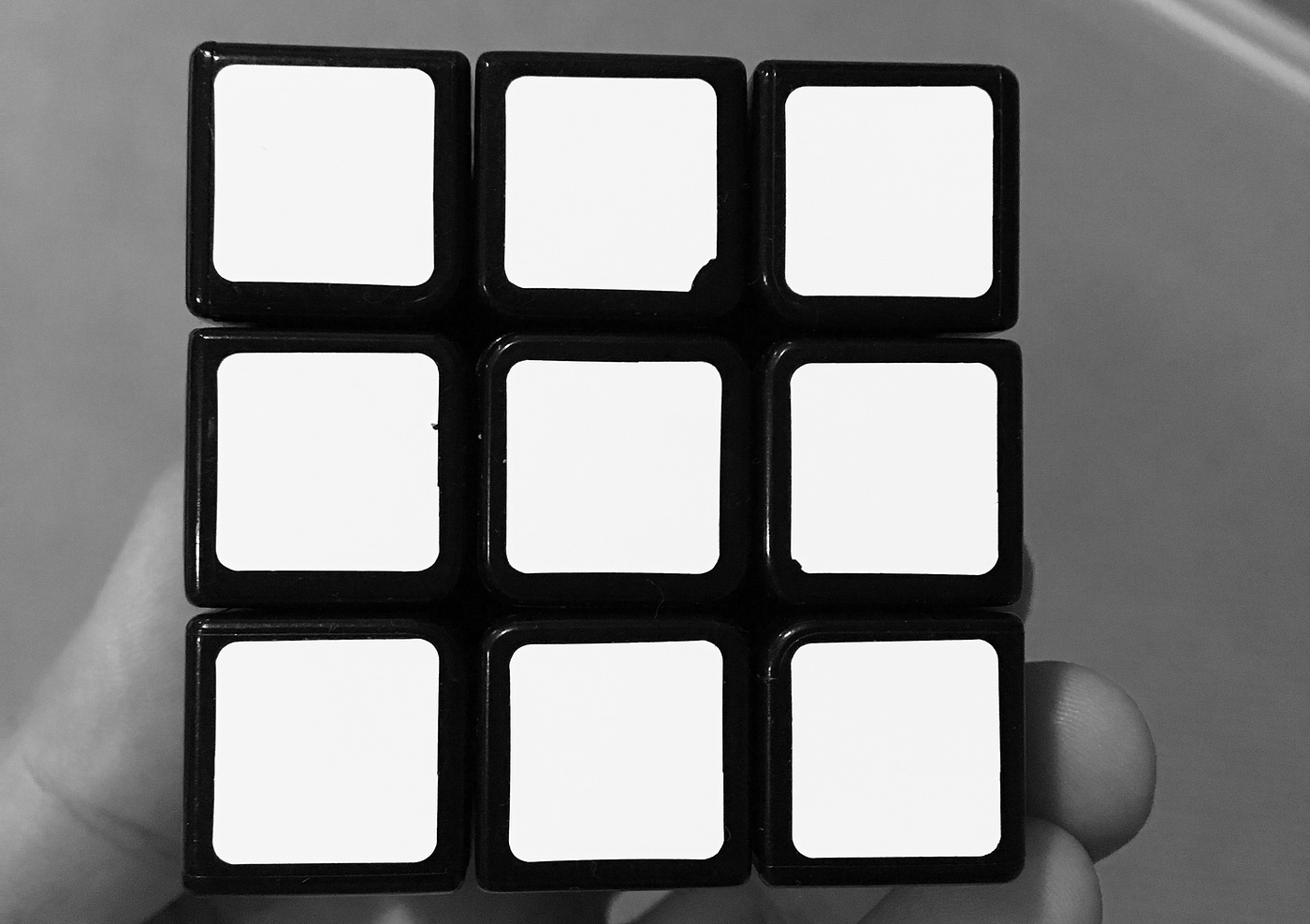
F2L is complete.
3. OLL (Orient the Concluding Layer)
At this point, the white side is completely solved and the first 2 layers of the cube (from the bottom) are solved. Thus, I merely need to solve the last layer of the cube.
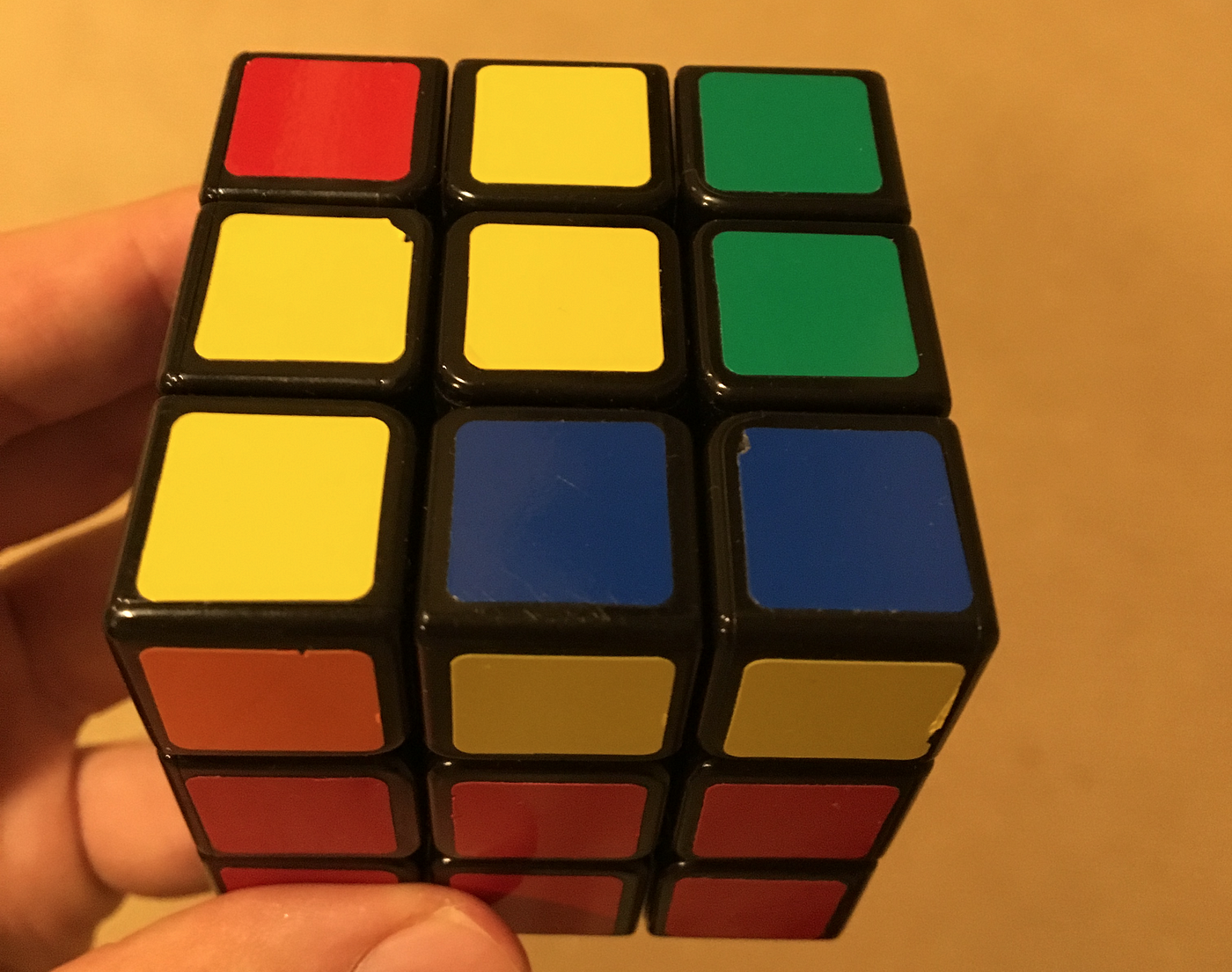
To do this, I intermission downwards the last layer into two parts. First, in this step, OLL, I solve the yellowish side, which is also known as orienting the last layer.
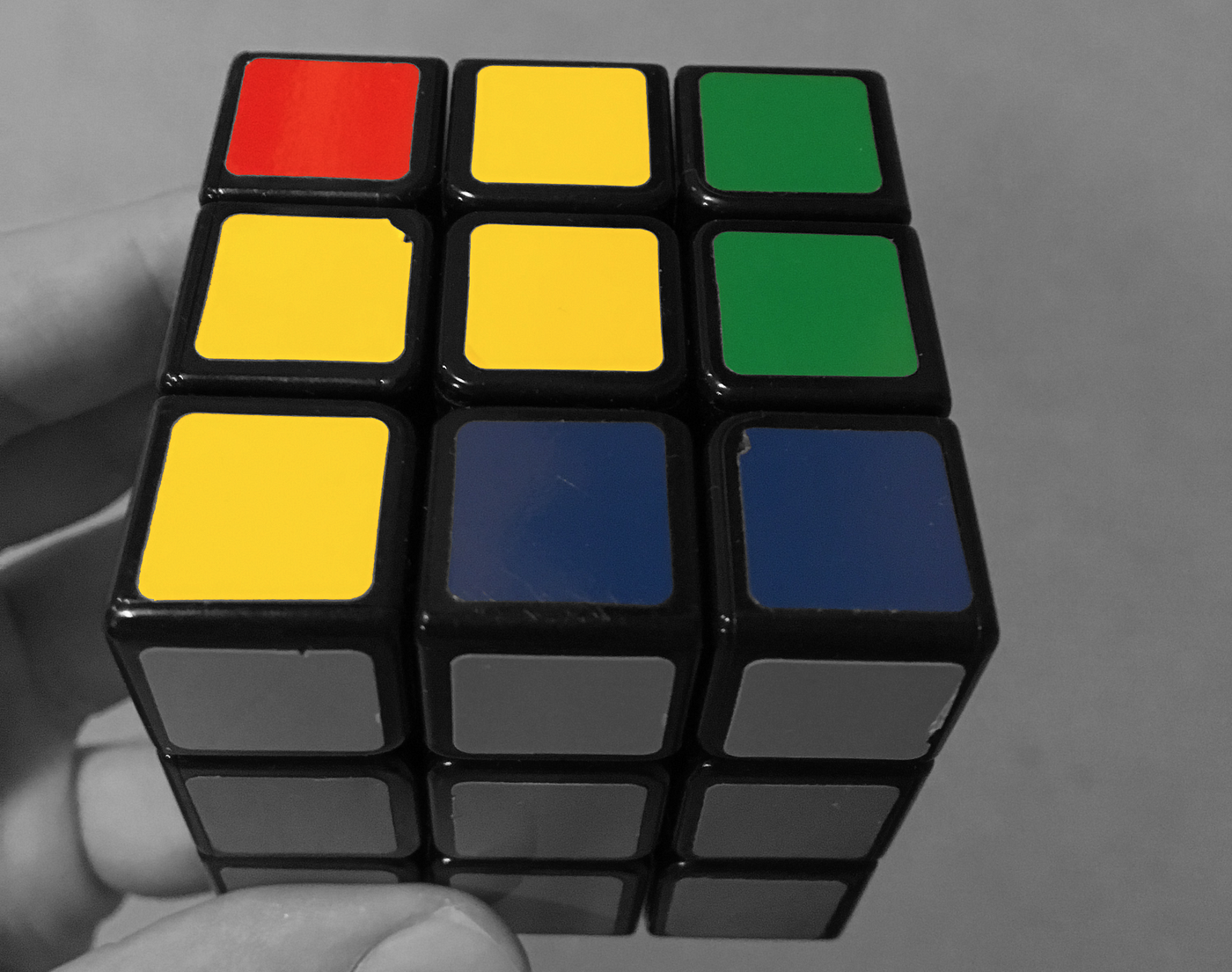
At this point, on the yellow face, it's possible for the xanthous pieces to be configured in 57 different means.
The fastest speed cubers accept memorized the 57 different algorithms necessary to most efficiently solve the 57 different configurations (i algorithm for each configuration).
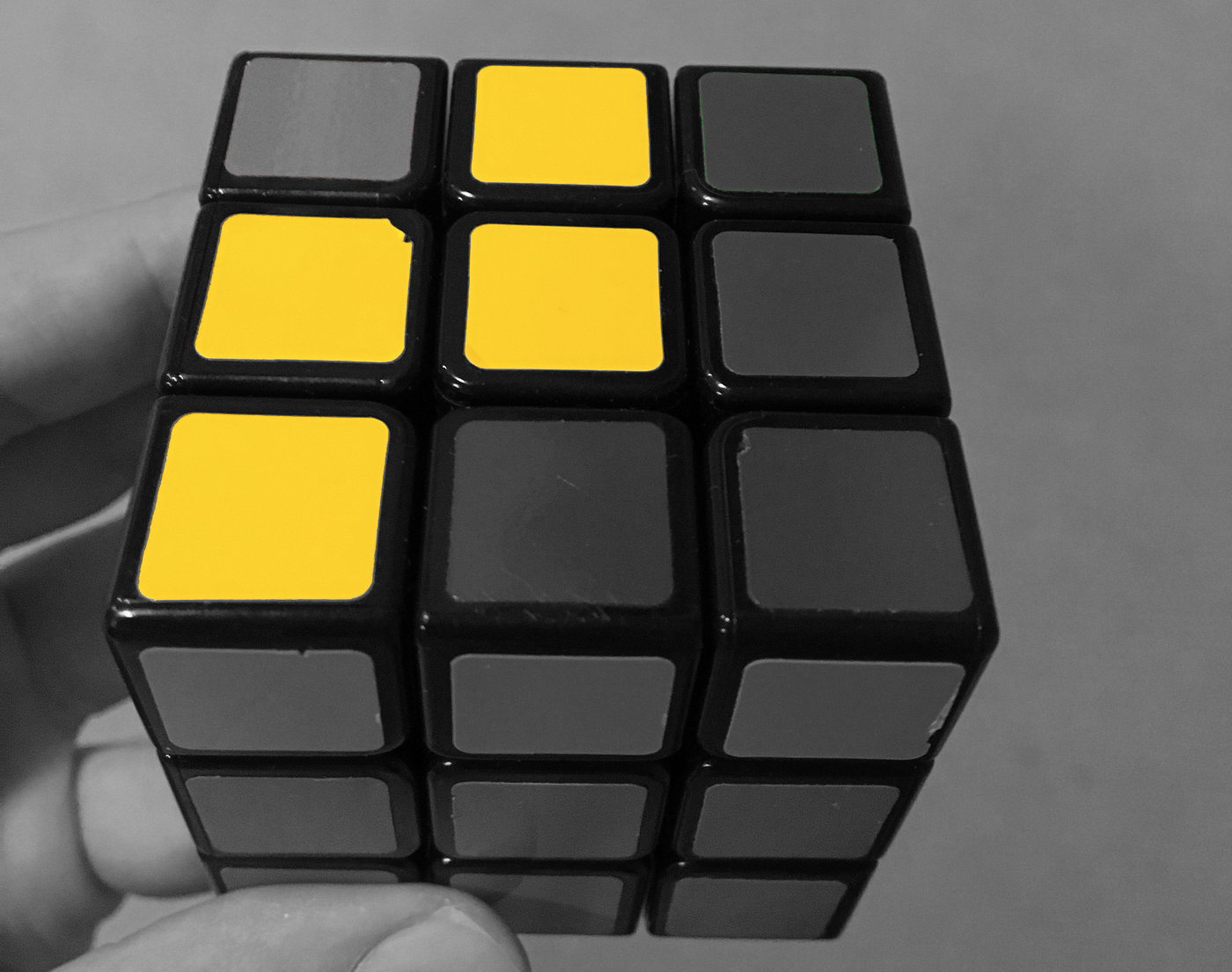
However, if you're willing to give upwardly efficiency, it'south possible to solve the yellow side with far fewer algorithms. I currently only know 9 of the algorithms, which means I'm highly inefficient at this step.
Upon completing the necessary algorithm, the yellow side is solved.
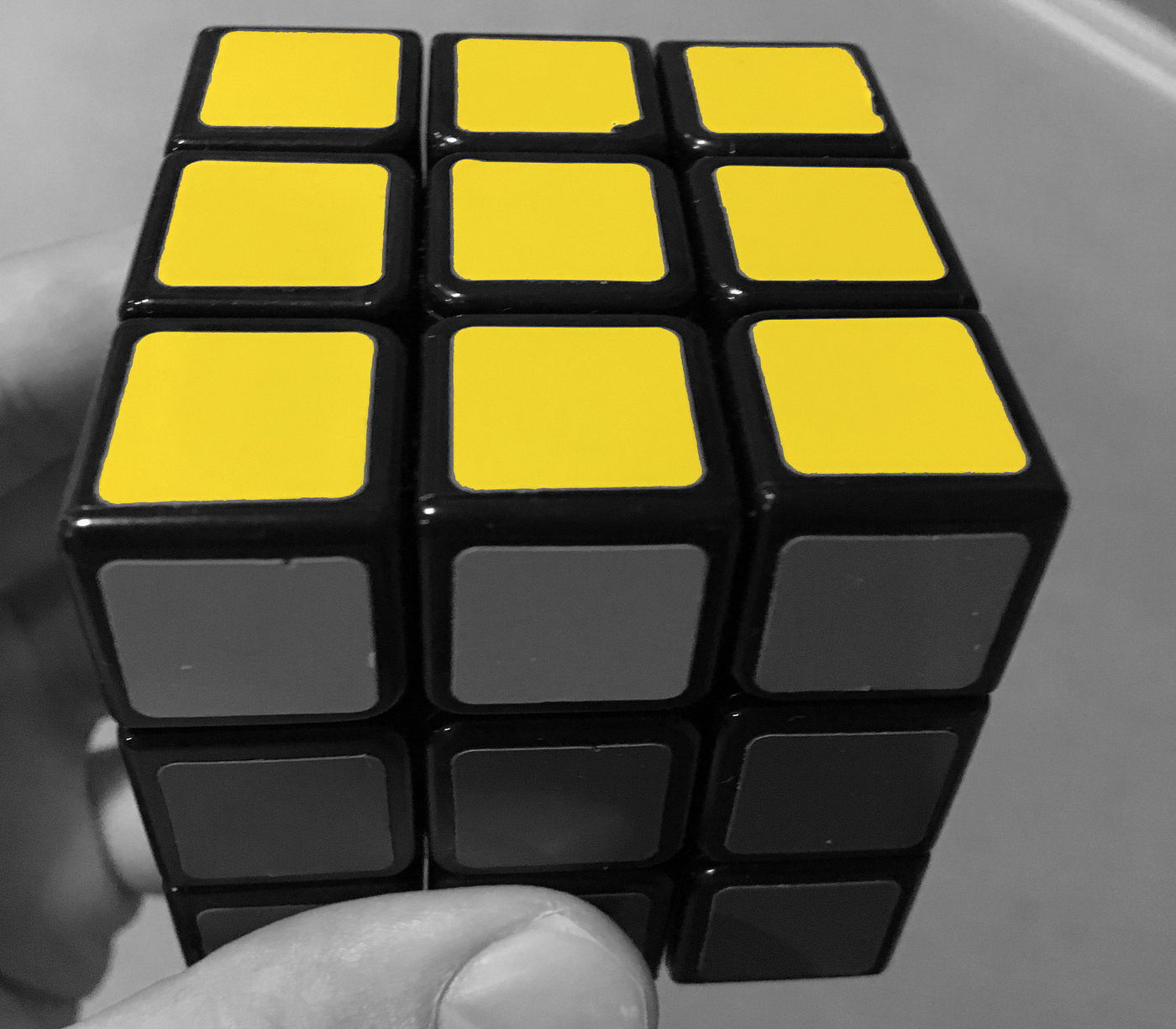
OLL is consummate.
4. PLL (Permute the Last Layer)
After finishing OLL, the cube looks like this.

The outset 2 layers and the yellow side are solved. The only thing left to solve, during this footstep, PLL, is the rim of the last layer, which is too know as permuting the terminal layer.
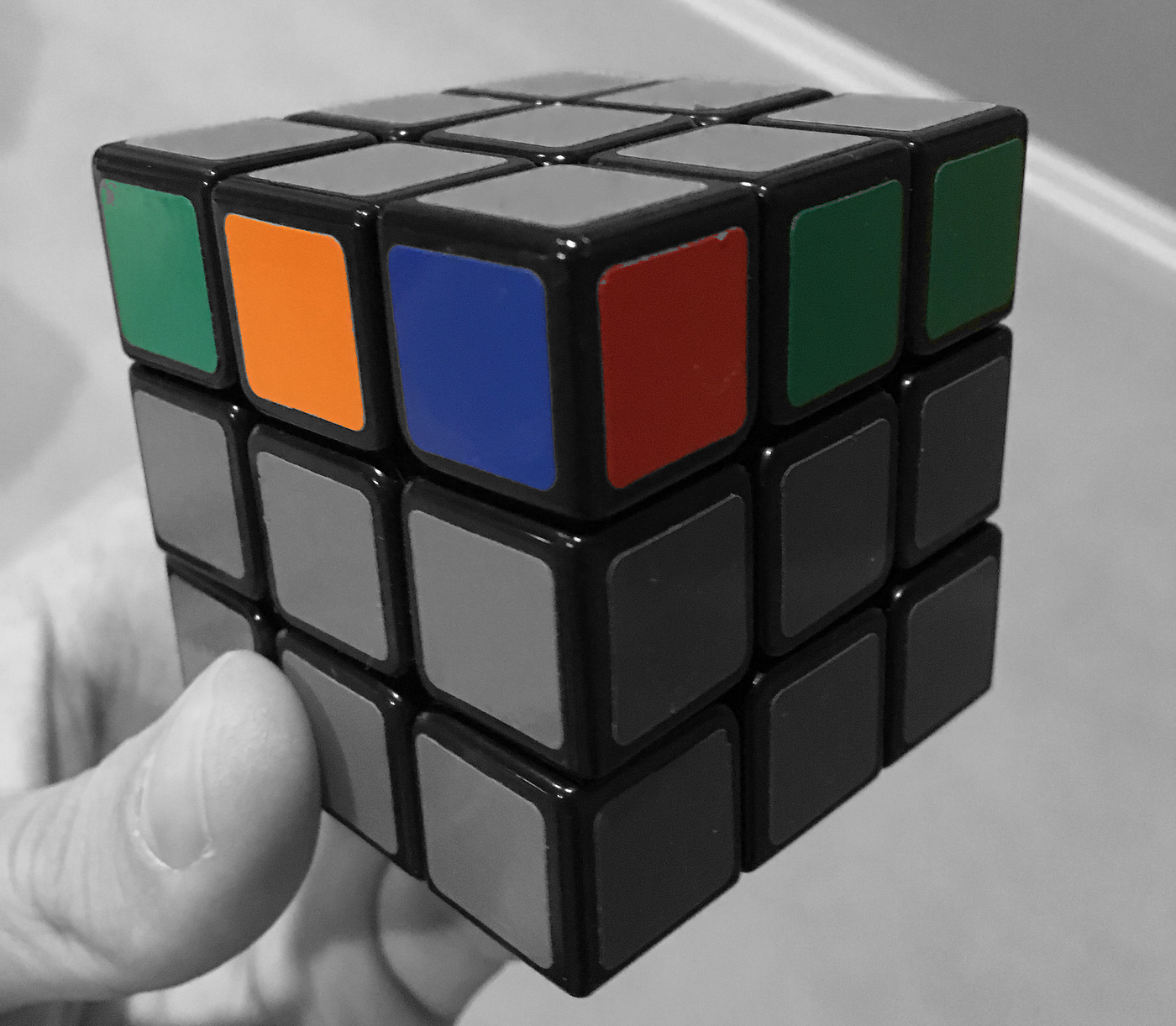
There are 21 different configurations for PLL, which can be solved most efficiently with the corresponding 21 algorithms.
I currently know vii of the PLL algorithms, which is enough to consummate PLL in twice as many moves as a competitive speed cuber.
Later executing the appropriate PLL algorithm, the rim of the last layer is solved.
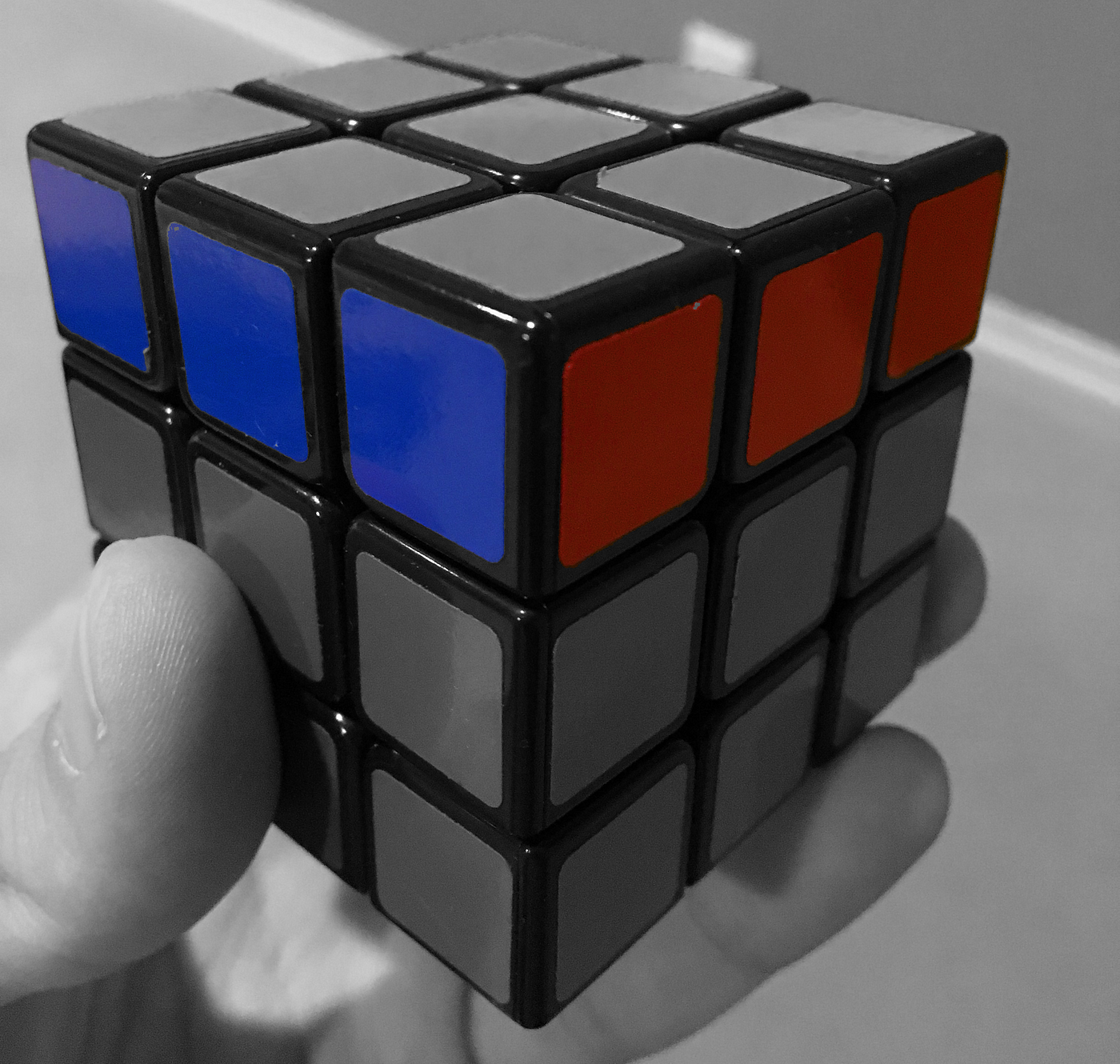
And as a effect, the entire cube is solved.


Going into each month, I take a reasonably skillful idea how I program to approach that month's claiming.
This calendar month, my program was simple: Learn the 62 Rubik'due south Cube algorithms I don't know. Obtain a sub-20 fourth dimension.
I figured that, since I know only 21% of the algorithms, learning the remaining 79% will drop my fourth dimension depression enough to run into my goal.
It turns out that information technology'southward not this simple.
Correct now, algorithms don't matter
Every bit a reminder, there are 4 steps to solving the Rubik's Cube (The cross, F2L, OLL, and PLL), which I explain in yesterday'south post. As a simplification, there are really 2 parts to the solve: The intuition-based role, which includes the cross and F2L, and the algorithm-based office, which includes OLL and PLL.
My original plan was just to focus on the algorithm-based part, since this approach seemed contained, very measurable, and well-defined. I would learn iii algorithms per day, leaving me one week at the finish to practice and perfect all the algorithms together.
Simply in that location'south a trouble: it takes me, on average, thirty–35 seconds simply to accomplish the algorithm-based part of the solve. In other words, even if I learned and could perform all 78 algorithms perfectly, at full speed, I wouldn't even reach that part of the solve until much after 20 seconds elapsed.
Basically, the intuition-based role (the cross and F2L) currently takes fashion also long, making it unignorable. In fact, since information technology makes up the bulk of my solve time, I will likely need to put much of my focus on these steps.
The xx-2nd breakdown
According to Rubik'southward Cube forums, if I want to solve the cube in 20 seconds, my fourth dimension should be allocated, more or less, in the following way.
- Cross: 2 seconds
- F2L: 10 seconds
- OLL: 2 seconds
- PLL: 6 seconds
Thus, I demand to throw out my algorithm-based plan, and instead, create unique plans for each stage to achieve the necessary times.
Of course, I can give and take seconds from step to stride, depending on where my strengths lie, but this is a good framework to showtime with.
Tomorrow, I need to start experimenting with F2L training techniques (since these past 3 days I've spent just learning new algorithms).
I have a hunch that I will be reprising November's use of a metronome…

Every bit mentioned yesterday, I need to decrease my speed on the intuition-based parts of my solve (the cross and F2L) in order to attain a sub-twenty time.
After analyzing a few of my solves, there's clearly one major thing currently slowing me downward: Cube Rotations.
What is a Cube Rotation?
If I turn the entire cube clockwise or counterclockwise around its vertical centrality, I've executed a cube rotation.
Executing a cube rotation doesn't get the cube any closer to the solved state, simply still costs valuable time. In fact, not only am I losing time executing the rotation, merely I'm as well losing time getting reoriented to the rotated cube. (For those who read most productivity, this is a chip like context switching , which has time implications beyond simply the act of switching tasks).
Equally a result, when solving, speed cubers attempt to minimize their number of executed cube rotations, aiming for one or two at the virtually.
Today, before analyzing some video, I imagined that my cube rotating was minimal (perhaps iv or 5 rotations per normal solve), but afterwards filming myself, I realize I'm an aggressive cube rotator.
Watch as I execute xiii cube rotations but while solving the cross and F2L…
I execute Cube Rotations for two reasons
The first is because I'm trying to observe the pieces I need to complete the cantankerous and F2L. I'll address this trouble, which I call Inspection Pauses, tomorrow.
The other reason I execute Cube Rotations is to gain positional leverage. In other words, it's easier for me to execute certain Rubik's Cube maneuvers when holding the cube in sure, better-skilful positions. Simply, I'm rotating the cube into more preferable orientations.
While I'm nicely compensating for my weaknesses, this isn't a salubrious practice (if I want to become universally faster). It's every bit if I learned how to play a guitar solo only in the cardinal of A major, and every time the band plays anything different, I need to stop the band and inquire them to transpose the song into the key I know.
Like a good guitarist, if I want to solve the Rubik's Cube fast, I need to be comfy with the full range of possibilities and all the ways they tin be presented to me — whether that'south all the possible musical keys of a song or all the possible ways a certain maneuver is oriented on the cube.
How I programme to become better (introducing FRS)
In order to practice cube maneuvers from all possible orientations, and besides in guild to reduce Cube Rotations, I've created a unproblematic exercise called Forced Rotationless Solving (FRS).
During FRS, Cube Rotations aren't immune. Instead, I must determine new means to solve the cantankerous and F2L, from new vantage points, without ever rotating the cube.
I've completed about 25 solves today using FRS and am already developing a knack for these new maneuvers. In particular, I've gotten skilful at inserting pairs in the back. I'll explicate specifically what this ways in a future postal service, simply generally it means that I can now (more than comfortably) solve pieces on the back face of the cube, rather than having to rotate the cube 180 degrees to solve them in the front.
During the rest of the month, I'll go on using FRS every bit a warmup exercise before I practice my normal speed solves.
Hopefully, I can drop the number of Cube Rotations during my solves into the low single digits.

Yesterday, I realized that Cube Rotations were majorly slowing me downwardly during the intuition-based parts of my Rubik's Cube solve. In an ideal world, I'd have merely i or two rotations per solve, simply instead, I have about 10–fifteen.
As a reminder, these are Cube Rotations…
Yesterday, I discussed the positional reasons for Cube Rotations (and introduced Forced Rotationless Solving, FRS, as a potential solution). Today, I'll address the other reason for rotations: Inspection Pauses.
Inspection Pauses
During F2L (solving the first 2 layers), I must correctly place viii pieces: iv pairs of corresponding corners and edges.
In other words, during F2L, I must create four corner-edge pairs, and then identify each pair in the correct position (called a "slot") on the cube.
If you sentinel the video above, you'll detect that I execute a fast series of moves. Then, I pause, rotate/inspect the cube until I detect the next pair of pieces, execute another series of fast moves, then on.
Basically, I'yard not able to flow fluidly from pair to pair during F2L. Instead, my F2L is cleaved up by these inspection pauses.
Looking into the future
If I want to eliminate Inspection Pauses, I demand to search for the next pair while I simultaneously execute the necessary moves for the current pair. In other words, I need to wait into the time to come.
This is tough.
And then, to practice, I've returned to using the Pulse metronome app, which I used in November to go a pseudo g master of memory.
Here'south the idea: I set the metronome to something small, like 90 BPM. And so, I attempt to solve the cube by making a plough every time the metronome clicks. As a result, by the nature of the exercise, all Inspection Pauses are (theoretically) eliminated, and the solve is consequent and fluid.
Even solving at ninety BPM, in this way, is surprisingly challenging for me. My encephalon actually needs to work hard to both execute the moves and search for the side by side pieces simultaneously. Only, as a result of this brain strain, I tin feel my cube vision improving.
Better cube vision = faster solves, so nightmare-inducing metronome clicks are dorsum in my life for at least the side by side calendar week.

When I first explained how I solve a Rubik's Cube, I noted that I always start past creating a cross on the white side. This consistency helps with speedy pattern recognition, but may non be the virtually efficient method.
Then, to address this potential inefficiency, I experimented today with Colour Neutrality.
What is Color Neutrality?
Under color neutrality, rather than always starting a solve with the white side of the cube, I must assess each unique scramble and identify which color seems easiest to start with (where easiest is some combination of fewest number of moves and ease of execution). The easiest color could be white, simply it could also exist yellow, blue, green, red, or orange.
Thus, to be a color neutral cuber, I must be able to 1) Rapidly identify the easiest starting color for a particular scramble, and two) Execute my solve with equal competency and pattern recognition from whatsoever starting colour.
To make up one's mind if Colour Neutrality is something worth pursuing, I needed to answer a couple of questions…
How much time would Colour Neutrality salvage me?
To answer this question, I timed myself solving xx crosses on the white side of the cube. I wanted to run across how much time I was saving between an piece of cake cross and a hard cross.
I constitute that my cross fourth dimension was betwixt two and 4 seconds, meaning perfect Color Neutrality, at best, volition relieve me only two seconds per solve. Of form, two seconds is significant if I desire to vanquish the world record (or if I'k consistently stuck at 22-2d solves), but information technology'south only a tiny boost in accented efficiency.
How much effort would information technology have?
Since I'd only be gaining two-ish seconds from Color Neutral solving, I needed to assess the investment level.
To do so, I completed x solves starting on a color other than white.
Surprisingly, I've never actually tried this, so I didn't know what to expect. The result was worse than I expected: On average, my Colour Neutral solves were most 30% slower than my solves starting with white.
This is a large hill to climb.
Of course, with practice, I can overcome this divergence, but I'one thousand merely not sure information technology's worth my attending during this month'southward challenge. Particularly since I'll only exist shaving i–2 seconds off my time for doing so.
I'm glad I went through the exploration, simply I feel my efforts are improve spent elsewhere.
What should You do?
If yous are just learning to solve the Rubik'southward Cube now, or if you ever plan to learn in the future, I would encourage you to offset practicing Colour Neutral solves equally early as possible (assuming you care about speed).
It seems that the better and better you lot get with one color, the harder it is to justify going backwards to proceeds Color Neutrality.
In fact, if I was simply learning how to solve the cube now, I would probably force myself to start each new solve with a different color than the previous solve. This is an easy mechanism to sympathise and follow, and will reap dainty Color Neutral rewards.

Today, I solved the Rubik's Cube 100 times, which took most ii hours (with a few breaks).
I started with twenty Forced Rotationless Solves, which helped improve my musculus memory for maneuvers in less common orientations.
Then, I executed thirty solves to a metronome at 100 BPM, which helped improve my look-ahead .
Finally, I completed 50 regular speed solves to put the pieces together (literally, I guess).
Calculation algorithms to my grooming
Over the past few days, I've merely been grooming the first part of my Rubik's Cube solve, ignoring the second, algorithms-based office.
Now that the exercises to train the "first part" are well-defined, it's time to start addressing new algorithms as part of my training authorities.
I'thou not sure if I can learn all the remaining algorithms in the adjacent three weeks, then tomorrow, I'll figure out which ones to focus on.

When I first described how I solve a Rubik's Cube, I alluded to the fact that some parts of the cube tin can be solved using a set of 78 algorithms, merely I didn't say much farther.
Today, I'll explain the fundamentals.
What is a Rubik's Cube algorithm?
Simply, an algorithm is a prepare of pre-determined moves that, when properly executed, achieve a specific task (i.e. "move these particular pieces on the cube into this particular configuration without moving/messing upward these other pieces").
The nearly common way to limited a Rubik's Cube algorithm is using Basic Notation, which is depicted beneath.

Nether the Basic Notation scheme, R means "plough the correct face of the cube clockwise". R' (R prime), means "turn the correct face of the cube counterclockwise". So on, with F = front; B = dorsum; L = Left; R = Correct; U = Upwardly; D = Downwards.
A full algorithm may look like this: F R U R' U' F'
When can you utilise Rubik's Cube algorithms?
Once you solve the beginning 2 layers of the cube, y'all enter the algorithm-based portion of the solve, which is focused on solving the last layer.
Here's what the cube looks similar at this indicate.
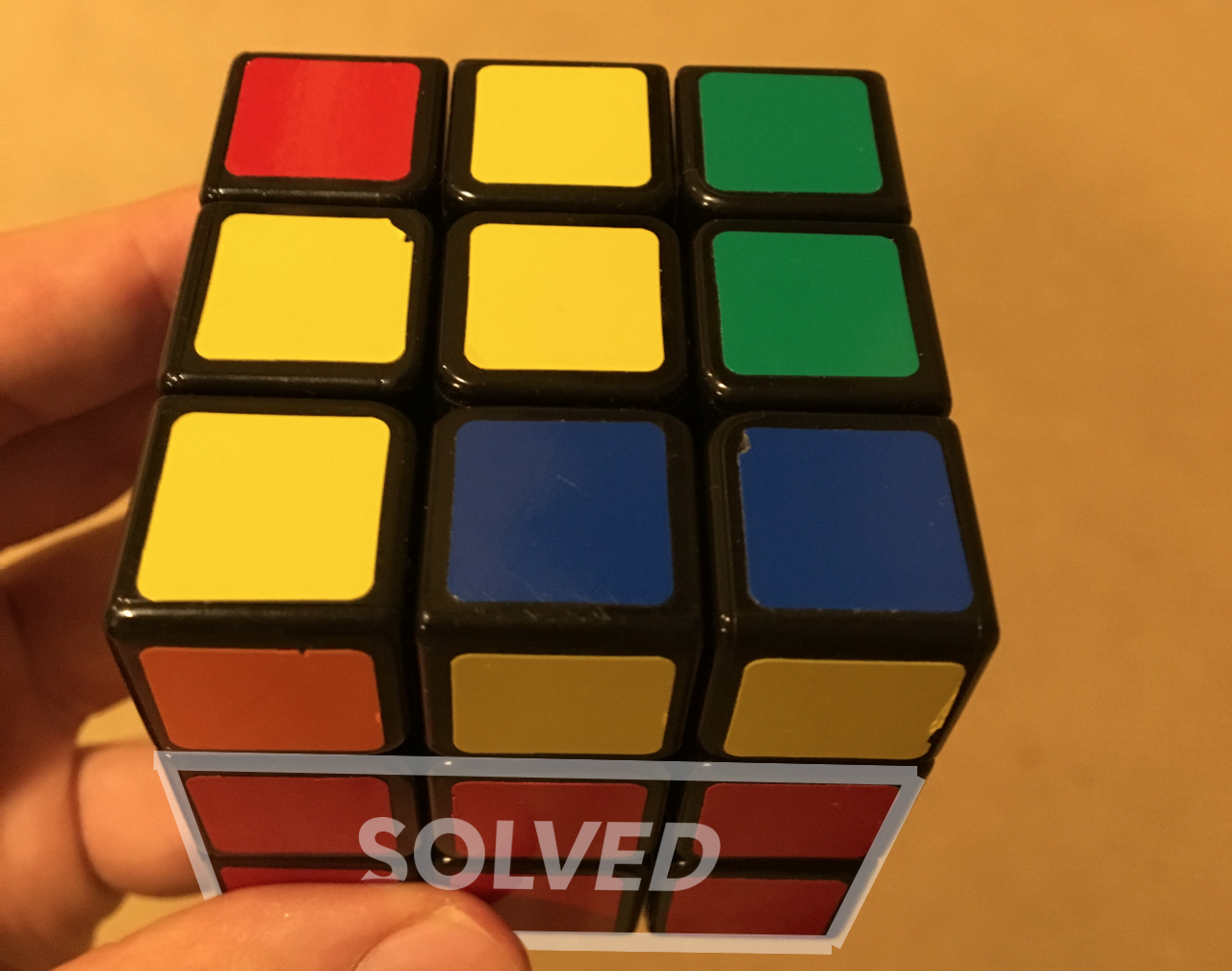
To solve the remaining part of the cube, yous must execute two classes of algorithms.
The first class of algorithms is called Orient Last Layer (OLL), which solves the top face up of the terminal layer.

In that location are 57 different algorithms to solve each of the 57 possible patterns.
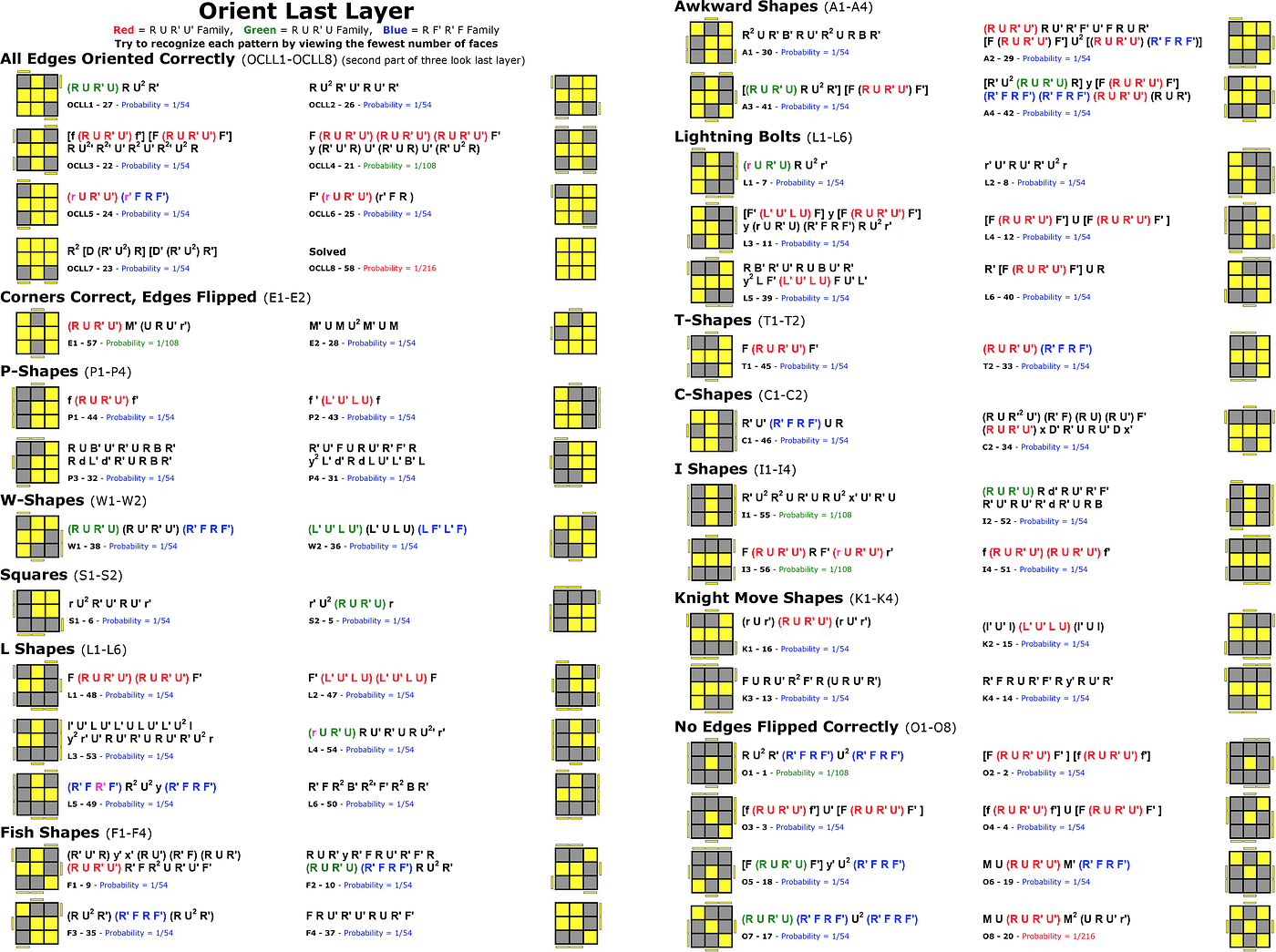
The second class of algorithms is called Permute Concluding Layer (PLL), which solves the rim of the final layer (and, as a event, the entire cube).

There are 21 PLL algorithms.

Which algorithms should I learn?
To solve the cube, yous merely need to know four OLL algorithms and four PLL algorithms. Only, to solve the cube fast, you demand to know as many every bit possible.
Since I don't remember I can learn all 78 this month, I need to decide which subset to study. Tomorrow, I will finish figuring this out and will write almost information technology.
How should I optimally practice algorithms?
This some other question I oasis't notwithstanding answered.
Once I determine my target algorithms, I'll experiment with some training ideas, and share out what I find.

Today, I was trying to select which set of concluding layer algorithms to learn, when I stumbled on something amazing…
2-Look OLL algorithms
As explained yesterday, 57 of the 78 Rubik'due south Cube algorithms are used for the Orient Last Layer (OLL) step of the solve. Thus, I suspected that OLL would make upwards most of my algorithm learning effort.
Nevertheless, surprisingly, after today, that's no longer true:
This forenoon, I learned almost something called Ii-Wait OLL, which basically means "If I'grand willing to string together 2 algorithms back to back (instead of using just i algorithm), I just need to learn 10 OLL algorithms to cover all 57 OLL patterns".
Here are those algorithms:
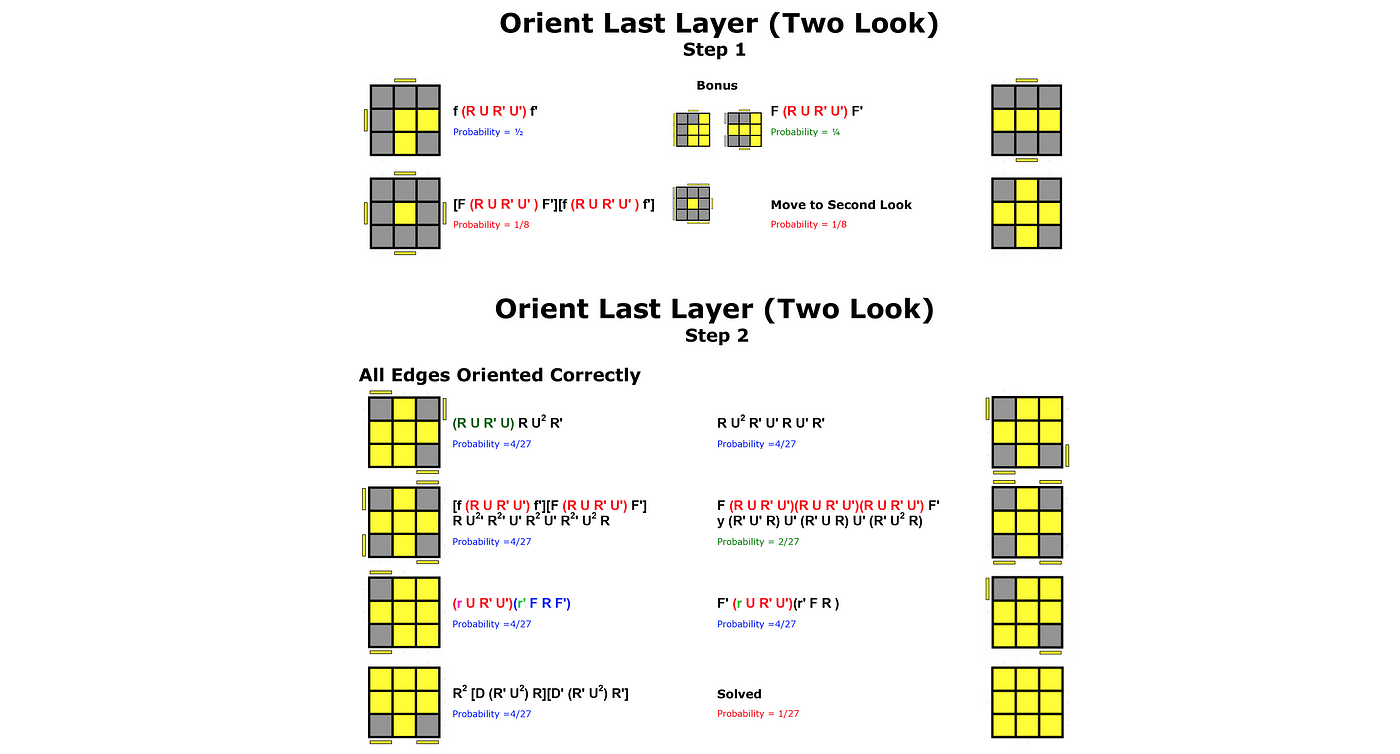
At the showtime of this month's challenge (and as of this morning), I but knew a random assortment of 9 OLL algorithms that I picked up over the by many years of coincidental cubing.
I have no idea why I know the particular set of algorithms I do. I merely do.
When I learned most "Two-Look OLL" this morning time, the first idea I had was "I wonder how many of the ix algs I know lucifer the 10 Two-Look algs". If I just linearly extrapolate the probability (which is perhaps combinatoricly naive), I would look something like a 15% lucifer.
However, unexpectedly, I already knew lxx% of the 2-wait algs. Somehow, vii out of the 9 algs I already knew perfectly matched 7 out of the x 2-look algs.
And, on meridian of that, the three algs I didn't know were only pocket-sized variations on others that I did. In fact, because these three algs were so similar to others (i.e. mirror images, one move apart…), I was able to learn all 3 new algs in ten minutes.
Usually, information technology would probably take a solar day to fully contain a new alg.
Thus, excitingly, as of today, I know all the OII algorithms I demand for this calendar month'southward challenge (I'll prove why ii-look is sufficient below).
Information technology feels oddly lucky how much overlap there was between the set of algorithms I knew and the gear up of algorithms I wanted to know, but I doubtable in that location is some underlying reason that propelled me to learn these particular algorithms in the first place. I'm just not sure what that underlying reason is.
If y'all're a speed cuber and have a reasonable approximate, exit a comment. I'd dear to know.
PLL algorithms
The remaining 21 algorithms (out of the 78) are used for the Permute Concluding Layer (PLL) pace.
Unlike OLL, I've decided to acquire all 21 this calendar month.
I already know seven, so, over the next ii weeks, I volition learn ane of the remaining 14 algs per twenty-four hour period. This volition beget me one full week, at the terminate of the month, where I can execute solves with full knowledge of all the relevant algorithms.
Volition this piece of work?
If I just learn Ii-Expect OLL and complete PLL, will I be able to execute sub-20-2nd solves? It looks similar the respond is yes:
I reviewed the video of solves I made on Mean solar day 1 of this challenge, and extracted a few relevant statistics.
On average, I was using iii.2 OLL algorithms and 2 PLL algorithms to complete the 5 solves.
With two-look OLL and complete PLL, I'll reduce the number of algs to 2 and 1 respectively. In other words, assuming fourth dimension maps linearly to 'number of algorithms', I'll be cutting my OLL fourth dimension by 1/3 and my PLL fourth dimension by 1/2.
In Solve 1 from the video, which is the most average solve (since I used iii OLL and 2 PLL algs), it took me half-dozen seconds to solve OLL and viii seconds to solve PLL.
Therefore, if I can reduce my times by the amounts above, I will theoretically be able to execute a 4-second OLL and a 4-second PLL, or, in total, an 8-second last layer.
In my post "I already need a new plan", eight seconds is exactly how much time I allocated myself for my 20-second solve:
- Cross: 2 seconds
- F2L: 10 seconds
- OLL: ii seconds
- PLL: 6 seconds
I'm shifting some of my PLL fourth dimension to OLL to recoup for ii-expect, but it seems similar it will work out.
Tomorrow, I'll outset practicing the new algs and make up one's mind which grooming methods are optimal.

Yesterday, I determined that I need to learn 14 more Rubik's Cube algorithms this calendar month. Today, I learned i of the fourteen.
Here was my arroyo :
- On the train ride to work, I proficient the movements of the algorithm over and over again. While doing so, I wasn't trying to apply the algorithm in context or solve the cube. Instead, I merely wanted to learn the feeling of executing the algorithm. I repeated the algorithm about 200 times until I felt I could execute it without consciously considering each of the individual moves.
- On the train ride abode, I executed the algorithm again, only this time, I watched what happened to the patterns on the cube. In detail, I was trying to learn how I could apace identify the design and associated algorithm (based normally on only seeing two or three sides of the cube), so that I could execute the new alg in flow during a solve.
- One time I got dwelling, I solved the cube completely twoscore times. During these solves, the new algorithm came up three times, giving me the hazard to assess how smoothly (and correctly) I could execute it. The first time didn't go so well, just the other two times flowed perfectly.
While this approach isn't too profound, it got the chore done.

Over the past 11 days, I've solved the Rubik's Cube probably 400–500 times, which is a lot. In add-on, I've also focused on learning new algorithms, and training my pattern recognition abilities with a few different exercises.
E'er after all of this practice so far, I withal don't seem to be getting much faster. In fact, some of the speed gains I saw in the first few days seem to be reverting (i.east. I'm going slower than I did ~4 days ago).
I have iv theories why this is happening:
i. My cube is getting worse at the same rate I'm getting better
Equally I practice more and more with my Rubik's Cube, information technology's out-of-the-box buttery smoothness is breaking downward. I think this is from a combination of dust and general wear and tear. In other words, the cube is getting harder to plow and sometimes locks upwards when I'm going actually fast.
It'southward possible that, every bit my cube gets slower, I'one thousand getting generally faster, so the effects cancel out and I'k left with an unchanging time.
The potential solution: Lube.
Yes, Rubik's Cube lube is a real thing and very popular amongst speed cubers. I've ordered some on Amazon and will put it to employ in one case it shows up.
two. My brain is getting overloaded
Two months ago, when I was trying to larn how to memorize a deck of cards in less than 2 minutes, between days 7–10, I dipped to my worst level of performance. My brain had been subjected to so much new information over the previous week, and hadn't nonetheless caught up. In one case it did, after a few days, I made a big spring frontward in my progress.
It'due south possible I'm experiencing a similar phenomenon now.
The potential solution: Don't get discouraged and push through. If I don't encounter positive changes in a few days, I should reassess this theory.
3. I'thou practicing poorly
I've noticed that, during real solves, I ignore a lot of the techniques I've been practicing. For example, I've been working difficult to reduce my cube rotationsand improve my look-ahead via ii main directed exercises. But, when it's fourth dimension to utilise these principles to an actual solve, I freak out, forget everything, and spin the cube frantically. This is conspicuously not good.
The potential solution: Combine my training exercises with actual solves, forcing myself to actively look-alee and proceed the cube positionally controlled.
four. Poor pre-solve planning
Before every solve, speed cubers are immune 15 seconds to inspect the scrambled cube. During this time, it'southward advised to make some sort of plan.
Typically, most speed cubers can plan out the entire cross and one F2L pair during inspection. On the other mitt, I seem to just plan, on average, two of the 4 edge pieces necessary to form the cantankerous.
As a result, my cross is still too ho-hum, and my transition to F2L is usually terrible. After I finish the cross, I suspension for maybe i–2 seconds just to assess the situation.
This is not skilful.
The potential solution: Practice planning out the full cross during inspection. Also, practice tracking an F2L pair while executing the cross, and so I can smoothly transition from the cross to F2L.
(Not sure what "the cross" or "F2L" are? Read my mail service about how I solve the Rubik'due south Cube )
Validating these theories
When learning new skills, particularly for speed, it'southward ever a good practice to course hypotheses about where the major inefficiencies lie, and then attempt to validate/invalidate these theories.
That's what I plan to practise over the next few days, which will educate my training moving forwards.

Yesterday, I took some time to reflect on the Rubik'southward Cube progress I've fabricated so far this month. I mentioned that I wasn't progressing at the step I was hoping, and I presented four theories equally to why I thought this might be.
Interestingly, when I started writing the commodity, I only had three theories in mind. The quaternary came to me while I was proofreading.
I tested this fourth theory today, and shaved two seconds off my average solve time. Information technology also reminded me something of import about life.
The Fourth Theory: Poor pre-solve planning
Yesterday, here's the theory I put forward:
Before every solve, speed cubers are allowed 15 seconds to inspect the scrambled cube. During this fourth dimension, information technology's advised to make some sort of programme.
Typically, most speed cubers can plan out the entire cross and one F2L pair during inspection. On the other hand, I seem to only plan, on average, two of the 4 edge pieces necessary to class the cross.
As a result, my cross is still also slow, and my transition to F2L is usually terrible. Afterwards I finish the cross, I pause for possibly i–ii seconds merely to assess the state of affairs.
Today, as a follow-up, I attempted to meliorate use my inspection time, which I expected I could improve over the next week with deliberate practice.
Even so, as presently as I started actively using my prep time, I was able to program for the entire cross during inspection without a problem. I gauge this is something I was already able to do (and was previously only beingness mentally lazy near).
The consequence: My solves were two seconds faster, on average, which is a nice bonus and a great help in my quest towards a 20-second solve.
It's interesting that I didn't recollect nigh this inefficiency earlier in the month.
A hiccup in my approach
Typically, the mode I approach learning a new skills is as follow:
- Breakdown the entire process finish-to-cease
- Identify which parts of the process I'm worse at / are causing the about inefficiencies
- Identify which parts of the procedure offer the most upside growth potential
- Overlay these two lists to make up one's mind how to prioritize my do
- Practice
- Repeat, as appropriate
However, when I was originally working through this approach, I was completely bullheaded to "the inspection phase" every bit part of the end-to-end process. In fact, in the post where I deconstruct the Rubik'due south Cube process, I never fifty-fifty mention inspection.
This was a big miss.
Why did I originally miss this?
I'm not actually surprised I missed inspection as role of my deconstruction.
I fell into a very common learning trap. Or maybe it's merely a life trap in general:
In life, nosotros are ofttimes so driven to succeed at our goals, that we jump right to execution without taking a moment to plan for and setup our success. As a result, fifty-fifty though it feels similar we're moving faster, we're really going slower.
Usually, this is the upshot of mental laziness. It's easier to distract our brains with "progress", than it is to thoughtfully plan and reflect on our goals.
My eagerness to solve the cube forced me into this not-usually-so-optimal behavior.
Anyway, I plan to use all 15 seconds of my inspection time moving forward.

On Day 1 of this month's challenge, I filmed myself solving the cube. My average solve time was 48.29 seconds.
Today, I filmed myself over again (solving the cube twenty times). During today's session, my average speed was 32.88 seconds, which represents solid progress.
Here are three of my best solves from today:

2 days ago, I mentioned that my cube is getting a fiddling stiff. So, I ordered Rubik'south Cube lube on Amazon.
Today, the lube showed up and I made an overly-cinematic video explaining my less-than-precise lubing technique.
It turns out, I used way likewise much lube.
The cube spins nicely, but I got the lube all over the outside, which is making it nearly impossible to hold on to the cube.
Luckily, I also ordered a few new cubes on Amazon, and they likewise showed up today, so I'll use those until I figure out how to effectively remove the excess lube.

When learning something new, I typically pass through four general stages:
- The Nuts: Learning is piece of cake and plentiful
- The Slump: Progress seems to standstill or regress
- The Leap: The pieces come together and progress leaps forward
- The Concluding Stretch: Progress accelerates until the goal is surpassed
Somehow, while I slept last nighttime, my grooming hardened in my brain, and I transitioned from The Slump to The Leap. In fact, this morn, I could consistently solve the Rubik's Cube five seconds faster than I could when I went to bed terminal night.
Not merely were my times faster, simply I could consciously feel the difference in the way I see and track patterns on the cube. I'm not certain what the divergence is, but I certainly feel it.
For anyone who's built software before, the feeling is similar to the following: Your code isn't working. Y'all've been debugging for a few hours, and goose egg seems to fix the trouble. All of sudden, while you're taking a shower, or eating dinner, etc., something clicks and you lot realize what the problem is and how to fix the problems. You lot haven't even so made the set up or tested the updated code, just you are certain that it volition piece of work. In the concurrently, you stand in the shower or sit down at the dinner table, feeling this weird mix of at peace and tremendously optimistic.
This is more or less how I feel. Something has clicked, and I'm now feeling really good.
Of class, this feeling comes at the toll of The Slump, which, for this month's challenge, lasted from around Twenty-four hour period iii until Mean solar day 14, significantly longer than the previous two months.
Anyway, I still have a lot of piece of work to do in order to achieve my sub-20 goal, but I now feel momentum is on my side.

Today, there's a lot weighing on my heed. And, while I appreciate the fact that some days are just like this, it definitely makes information technology challenging to solve the Rubik'due south Cube as fast as I know I can.
In other words, in order to solve the cube chop-chop, it'due south important that I get fully in the zone, and today, my brain doesn't want to exercise that. Instead, my mind is wandering in the centre of solves.
How to fix this?
Of course, the best way to fix this is to address the underlying problem, which I'm working on.
In the meantime, I came up with a clever little hack that'southward been helping, which requires a modest explanation:
In Nov, my goal was to learn how to memorize a deck of cards in under two minutes, which also required complete concentration. Thus, while I trained, to assistance eliminate external distractions, I would listen to a combination of white dissonance and rain sounds in my headphones. Later on a while, the white racket became a trigger for me to go in the zone.
Basically, every time I hear the white noise, my brain automatically gets into the associated fully focused country, ready to memorize cards (or in this case, solve a Rubik'southward Cube).
So today, even though the dissonance is coming from inside my own head, the white racket really helped. The trigger is notwithstanding stiff.
I can't continue relying on this hack for too long. Otherwise, I'll probably override the trigger or at least lessen its effect.
Simply, for today, it's working for me.

When I first put together the listing for my 12 Month to Master challenges, I picked things that were ambitiously out-of-reach. This was on purpose. I wanted goals that seriously challenged my interests, and would push my skills towards genuine mastery.
Over the past 78 days, as I've explained the project to many and written my daily blog posts, I've slowly become numb to my challenges. My passion is still at that place (mostly), only my guess of the challenges' difficulty has certainly dropped a lot.
This is probably the upshot of recognition bias combined with prematurely converting my goals to social reality .
If I don't recalibrate my perspective presently, though, I fear that my passion will also become numb.
Luckily, today helped put things back in perspective: As I continue making progress towards this calendar month'due south goal, I realize "Solving a Rubik'due south Cube in under 20 seconds is crazy difficult. Especially in this timeframe".
And while I've already articulated the difficulty of this challenge on January 1st, today was the starting time twenty-four hours in many days where I emotionally experience connected to that challenge.
I take a renewed hunger, and 14 more days. Time to make it happen.

With renewed passion for this month'southward challenge, I filmed five new solves today and performed surprisingly well. The boilerplate of the five was 22.414 seconds, with a single time of 21.587, only a couple seconds off my target time.
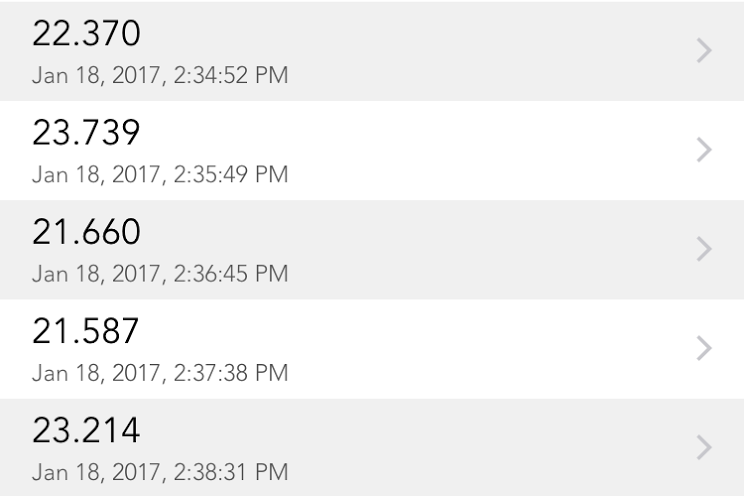
I somehow messed upwards filming the first solve, but I was able to capture the last 4 on photographic camera.
I'1000 getting excitingly close.

Yesterday, I figured out how to consistently solve the cube at my superlative speed. I just can't do it consistently.
Allow me explain by illustration…
The "golfing" analogy
I don't golf game very often. Perhaps, once per twelvemonth, at the well-nigh. But, when I do go, I continue to relearn the same lesson over and over: If I want to hit the ball hard, I shouldn't endeavour to hit the brawl hard.
In other words, a irksome, smooth swing nigh ever performs better than a fully-muscled shot. This is especially true when you don't play golf, which I don't.
Thus, when I get golfing, I make certain to remind myself to swing slowly before each shot. However, for the most function, I tin can't seem to listen to my own communication.
A typical progression of golf game shots
For the first shot, I swing smoothly, and the ball flies off my club. Crawly.
For the adjacent shot, I swing smoothly, and the ball once more travels far and straight.
For the third shot, I now feel force per unit area to replicate the success of my first two shots, and, equally a result, swing harder (to "ensure" the ball goes simply as far). Of course, the opposite happens, I mishit the brawl, and it falls curt.
Thus, to recoup for the short shot, I swing fifty-fifty harder on the next one, once more mishitting the ball. So on.
For the residual of my time golfing, I attempt to escape this downward psychological screw.
This is the odd affair nigh golf: Even though I know exactly what I demand to do in order to be successful, I can't seem to convince myself to consistently do it.
Speed cubing is no different
Speed cubing is very similar to golf game in this fashion: If I spin the cube calmly and slowly, my solve-times are noticeably faster than when I spin the cube as fast as I can. This is something that I fully acknowledge and believe.
Nevertheless, like golf, it's non and so like shooting fish in a barrel to spin the cube calmly and slowly — especially when I'm trying to intermission my ain personal speed record on every try.
Hither's what unremarkably happens: I spin the cube as well apace. My solve-time suffers. I spin the cube fifty-fifty faster the next time to recoup. I enter the golf-similar downwards spiral.
This problem becomes especially pronounced when I have out my camera to movie a few solves. In these cases, I really want to perform well, which usually ways I perform worse. ( Read virtually how I use lube to adjourn performance anxiety ).
Yesterday, then, was a flake of a miracle. I started filming myself, remained totally at-home, and nearly surpassed my speed goal.
If I can maintain this aforementioned mindset, I should be able to execute a sub-20-2nd solve whatever mean solar day now.

For virtually of my posts this calendar month, I've described how speed cubing challenges my spatial sensation, pattern recognition, discipline, etc. Basically, I've categorized speed cubing as a cerebral claiming more than annihilation else.
However, today, I couldn't help but notice the physical / dexterous component to cubing: Unexpectedly, my cubing muscles were sore.
This by week, I started working out once more at full intensity in grooming for my upcoming physical M2M challenges. In item, among other things, I did a lot of pull-ups, which challenged my grip, forearm, and finger strength.
As a upshot, my fingers (by way of my forearms) were sore today. I didn't think this would exist a large deal, given that speed cubing doesn't seem to require much physical forcefulness, but I was wrong.
As I battled the soreness in my hands and arms, my solve-times clocked in virtually iii–v seconds slower than yesterday. Not good.
Hopefully, the soreness goes abroad tomorrow, and I can take a few unencumbered attempts at completing this month'south claiming.
I'll concur off on more pull-ups until I'1000 officially sub-20.

Today, since it wasn't raining for the first time in a while, I spent most of the morning and afternoon walking laps around San Francisco listening to an audiobook. Currently, I'm listening to Spaceman past astronaut Mike Massimino (if you're interested, hither's my book list from 2016 ).
I got home around 5:30pm, and decided to moving picture a few Rubik'south Cube solves before dinner.
On my second endeavor, I solved the cube in xx.720 seconds, merely 0.73 seconds away from this month's goal and my fastest solve on video and then far.
The solve before this one, I completed in 21.787. The solve after, in 21.146.
I'm so consistently executing solves effectually the 20-second marking that I'm surprised I haven't filmed a sub-xx endeavor nevertheless. Information technology seems like there should be way more than variance and luck involved here. Peculiarly since my cognition and execution abilities of the Rubik's Cube algorithms aren't uniformly distributed.
I'chiliad not complaining about my consistency. I think it'southward a practiced thing. It only doesn't seem mathematically possible.
Anyhow, I'll continue focusing on systemically lowering my boilerplate solve fourth dimension. That'southward probably amend than relying on variance anyway.

Today, I solved the Rubik's Cube in 19.632 seconds, officially completing this calendar month'due south claiming.
This was specially exciting because I caught information technology on camera — or then I thought. It turns out my cinematography today was less than ideal: The cube is simply framed halfway in the shot.
In other words, I turned on my camera, executed a sub-20-second solve, and still failed to fully capture the moment. Bit of a bummer.
Then, while I've completed this month's challenge (overnice!), I'1000 not going to celebrate until I have a amend video to testify it.
Until then, I'one thousand going to zoom all the way out, and keep trying.

Yesterday, I completed this month'southward claiming (I solved the Rubik's Cube in nineteen.632 seconds), but I did it in the virtually unexciting way (the camera was poorly aimed).
Today, I decided to have a pause from speed cubing and just relax. I'll film some more than solves tomorrow (with the hope that I capture a better-framed sub-twenty solve).
In the concurrently, today, I rewatched my recent videos, looking for ways in which I tin amend, and in that location are many. In particular, I'chiliad still being very sloppy: Although my lookahead is much improve, I'm still relying also heavily on cube rotations, just considering information technology feels more comfortable.
Tomorrow, I'll make certain my first 20 solves are Forced Rotationless Solves(i.e. no cube rotations allowed) at full speed. Hopefully this volition inspire some discipline…

Today, I solved the Rubik's Cube in 17.704 seconds, 2.iii seconds faster than my sub-20 goal. This month's challenge is officially complete!
Technically, I already completed the challenge two days agone, when I solved the cube in 19.632 second, just the cube was mostly out-of-frame during the video. And then, today, I made certain to accept the entire solve fully in frame.
While this month's claiming is complete, I even so have a number of Rubik's Cube goals, like sub-xx boilerplate of five, sub-10, sub-lx blindfolded, and fewest moves. I'll discuss these tomorrow…

Yesterday, I officially completed this month'southward claiming, solving the Rubik's Cube in 17.704 seconds.
And while this month's challenge is over, I still accept further Rubik's Cube aspirations…
Sub-twenty average of v
In competition, there are ii chief speed cubing events: single solve and average of v. Yesterday, I completed a sub-20 single solve (i.e. I solved the cube one fourth dimension in nether 20 seconds). Notwithstanding, I have non yet completed a sub-20 average of five (where the average of 5 solves, excluding the top and bottom times, is less than 20 seconds).
This is the next goal I'k striving towards. Information technology's even peradventure possible for me to accomplish this earlier the end of January.
Sub-10 single
Solving the Rubik's Cube in single-digit seconds is a feat but reserved for a minority of top speed cubers. I have a lot of piece of work to exercise to cut my current time in half, only, perhaps with a fiddling luck, I could do information technology within some other month or 2 of practice.
Sub-60 Blindfolded
I've previously experimented with blindfolded solving, but I'grand horribly slow (it takes me about 10 minutes to memorize the cube and two minutes to solve). I would love to exist able to both memorize and solve in under 60 seconds.
Fewest Moves Challenge (FMC)
Exterior the realm of speed cubing is a Rubik'south Cube upshot called Fewest Moves Challenge or FMC. With FMC, you are given a scrambled cube, paper and pencil, and one hours; and your objective is to find the most efficient solve for that particular scramble. In other words, the goal is to find the solve that uses the fewest moves (that aren't just a reversal of the scramble itself).
To me, the role of FMC that is particularly interesting is called God's Number. Basically, some researchers at Google determined that every possible Rubik's Cube scramble can be completed in 20 moves or less. Thus, the number 20 is considered God's Number (since god should be able to solve any Rubik's Cube in no more than 20 moves).
The implications for FMC are clear: Can I beat God's Number and find an optimal solve that is less than 20 moves?
The crazy thing is… in competition, three cubers (Marcel Peters, Tim Wong, and Vladislav Ushakov) have outperformed God'south Number and solved the cube in only 19 moves.
I would love to exist the fourth.
Anyway, I share these challenges because I remember they're interesting, I'm inspired to pursue them, and I wanted to demonstrate the diversity of pursuits bachelor even in such a narrow discipline like cubing.

Over the past 3.v weeks, I've significantly improved my speed cubing abilities (to the betoken where I tin can consistently solve the cube in effectually 20 seconds).
Nevertheless, information technology was hard for me to fully appreciate my progress, until I watched side-by-side videos of solves from Day ane and Day 24 of this challenge (which are effectively the before and after videos).
Although, out of the gate, my speed seems reasonably similar, my efficiency on Mean solar day 24 dominates my Day one solve. In fact, the Day 24 solve is nearly three times faster than the solve from Mean solar day 1.
It's pretty striking… (go along nearly of your attending on Day 24)

In the video where I solve the Rubik's Cube in 17 seconds, before I starting time solving, I scramble the cube according to a serial of xx moves.
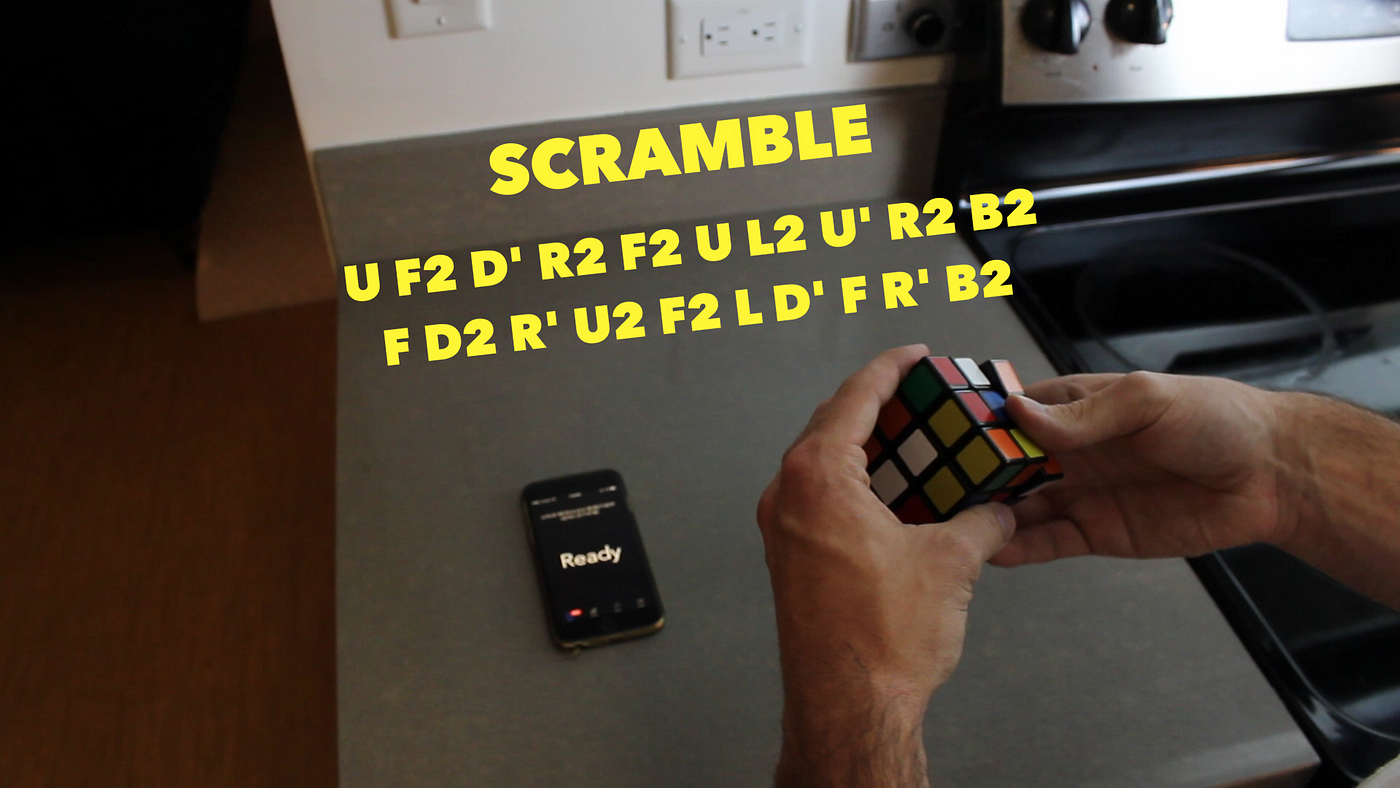
After sharing the video, many people asked where this scramble came from, if it's random, if I've practice it before, etc. So, I thought I'd accost that today…
I employ an app called ChaoTimer to automatically generate new, random scrambles on every solve.
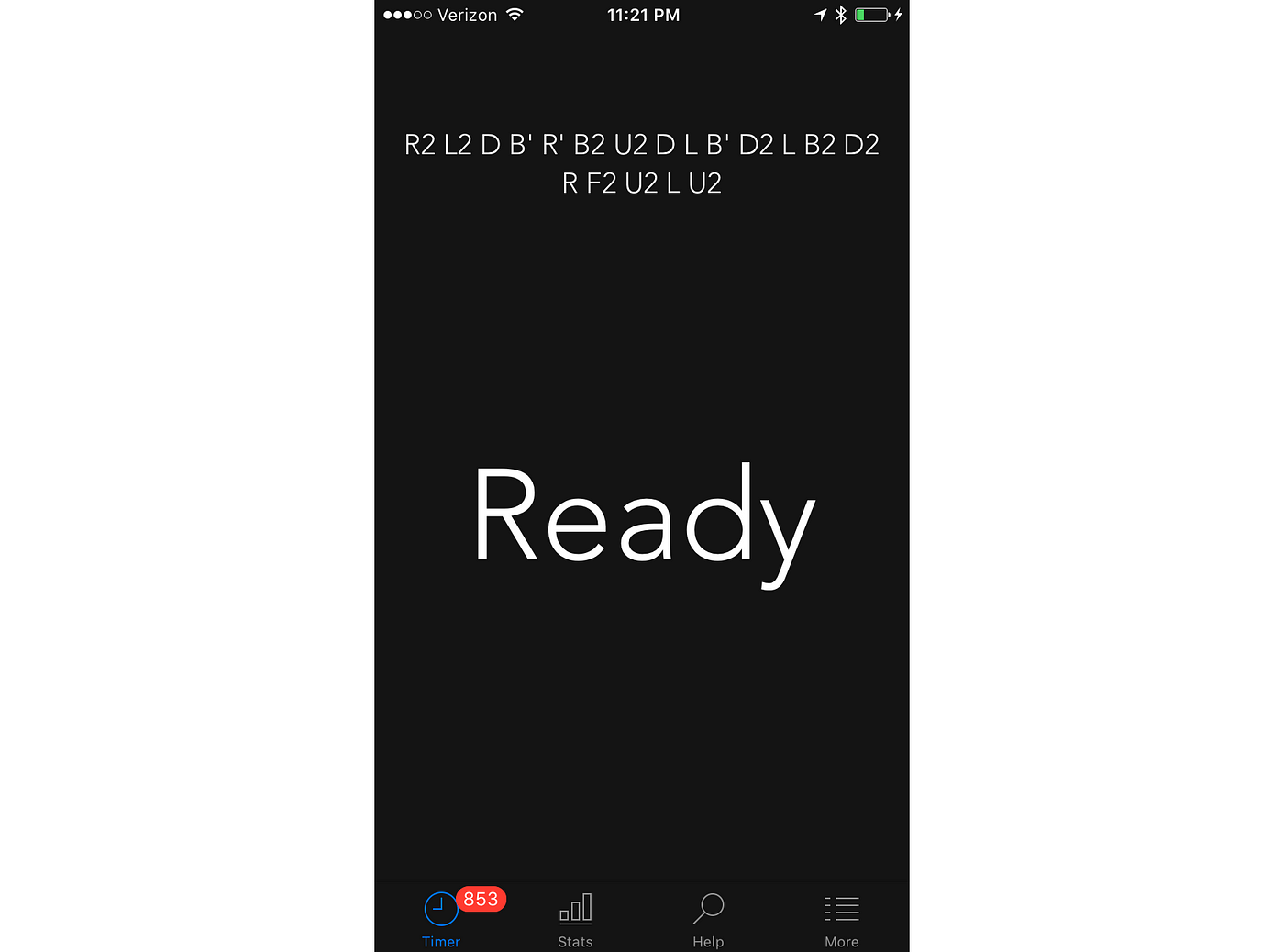
Each scramble is expressed using Basic Annotation, which is depicted below.

Nether the Basic Annotation scheme, R ways "turn the right face of the cube clockwise". R' (R prime), ways "turn the right face up of the cube counterclockwise". R2 means "turn the right face of the cube 180 degrees". And so on, with F = front; B = back; L = Left; R = Right; U = Up; D = Downwards.
You can run across in the screen shot above that I've but solved the Rubik's Cube 853 times this calendar month while using the app. There are 43,252,003,274,489,856,000 possible Rubik's Cube scrambles, all of which can exist generated in twenty moves.
Thus, I'm most sure that I've never had the same scramble twice.
Anyway, if you're interested in speed cubing, I'd highly recommend downloading the ChaoTimer app. Not only does it generate scrambles, only it likewise keeps fourth dimension and crunches a bunch of statistics most your solves.

Even though I surpassed my speed cubing goal four days ago, I go on to spend the same amount of time every twenty-four hours solving the Rubik's Cube.
However, since completing this month's claiming, I haven't made any noticeable improvements to my skills. In other words, I'm spending the same corporeality of fourth dimension speed cubing, but enjoying none of the gains I saw previously.
Sure, information technology feels similar I'yard "practicing", merely I'm not really practicing. Instead, I'm but going through the motions that are now comfortable and easy. My human relationship with the Rubik's Cube has reverted back to tactile distraction, and nothing more.
I'yard not saying this is a bad thing: I'm happy to bask the cube in this more relaxed way. But, it does help me capeesh the value of painfully deliberate practice.
The truth is, to meliorate at anything, especially in a brusk period of time, information technology's necessary to endure a sure kind of pain while practicing. I don't think it's a bad kind of pain (it feels skillful, like going to the gym), but it takes a lot of willpower to enter into and sustain this country of hurting for an entire practice session.
Since I no longer have a measurable goal to pursue or a desired timeframe to contain this non-existent pursuit, it'south much harder to motivate the kind of practice that yields noticeable changes from solar day to day.
Luckily, I take the Month to Master framework in place to assist enforce, structure, and inspire deliberate practice near of the fourth dimension. In a few days, a new month will start, and I will regain my hunger to endure the happy kind of pain.
Until so, I'll continue to relish my visit to the land of casual cubing…

Today, I wanted to practise something creative. So, in the spirit of cubing, I made a behemothic floating cube out of bluish tape. It took me about forty minutes.
I honestly don't accept any further explanation across "tape art is apparently a good creative outlet"…
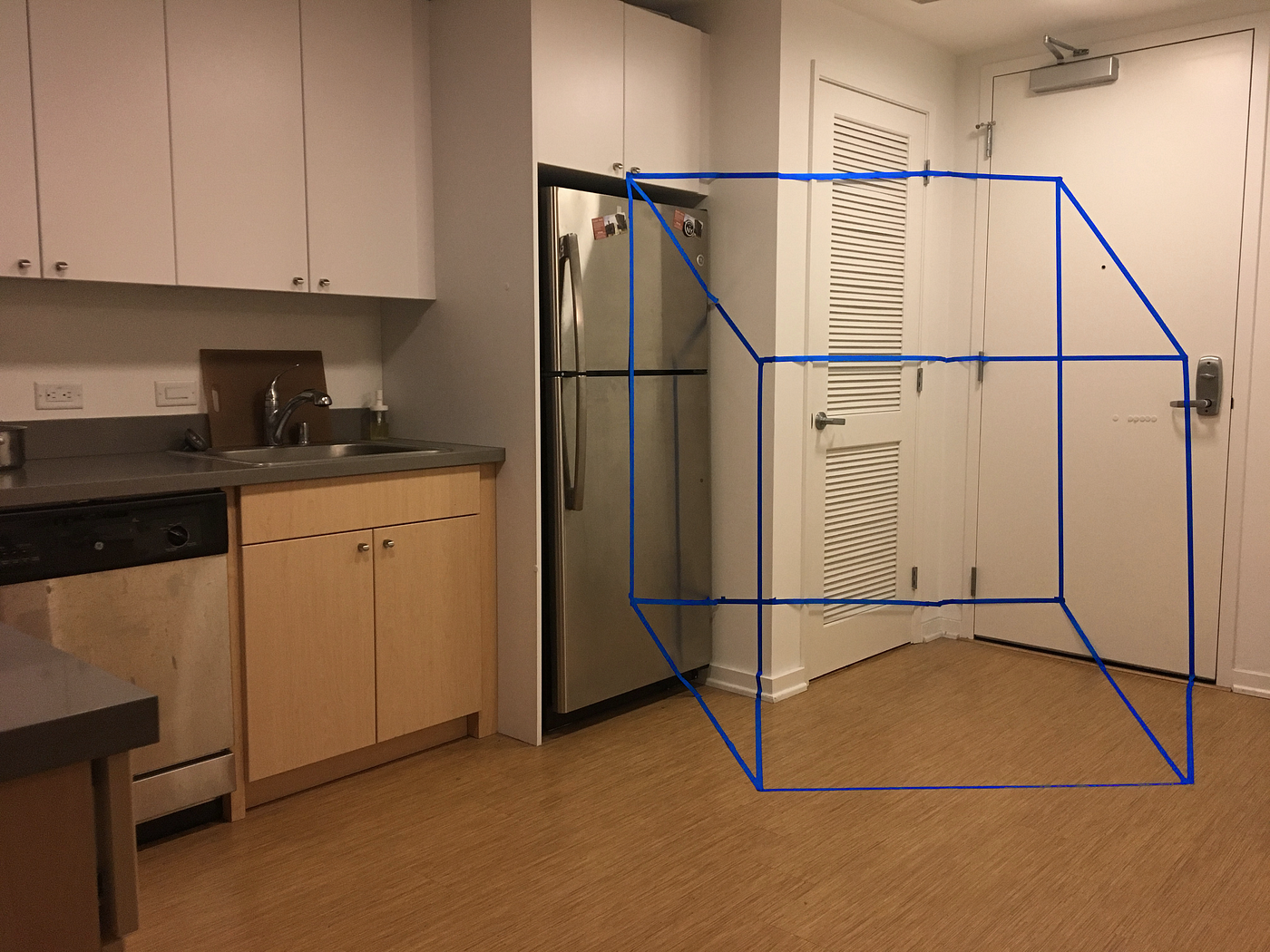
Here's the cube from some illusion-breaking angles:
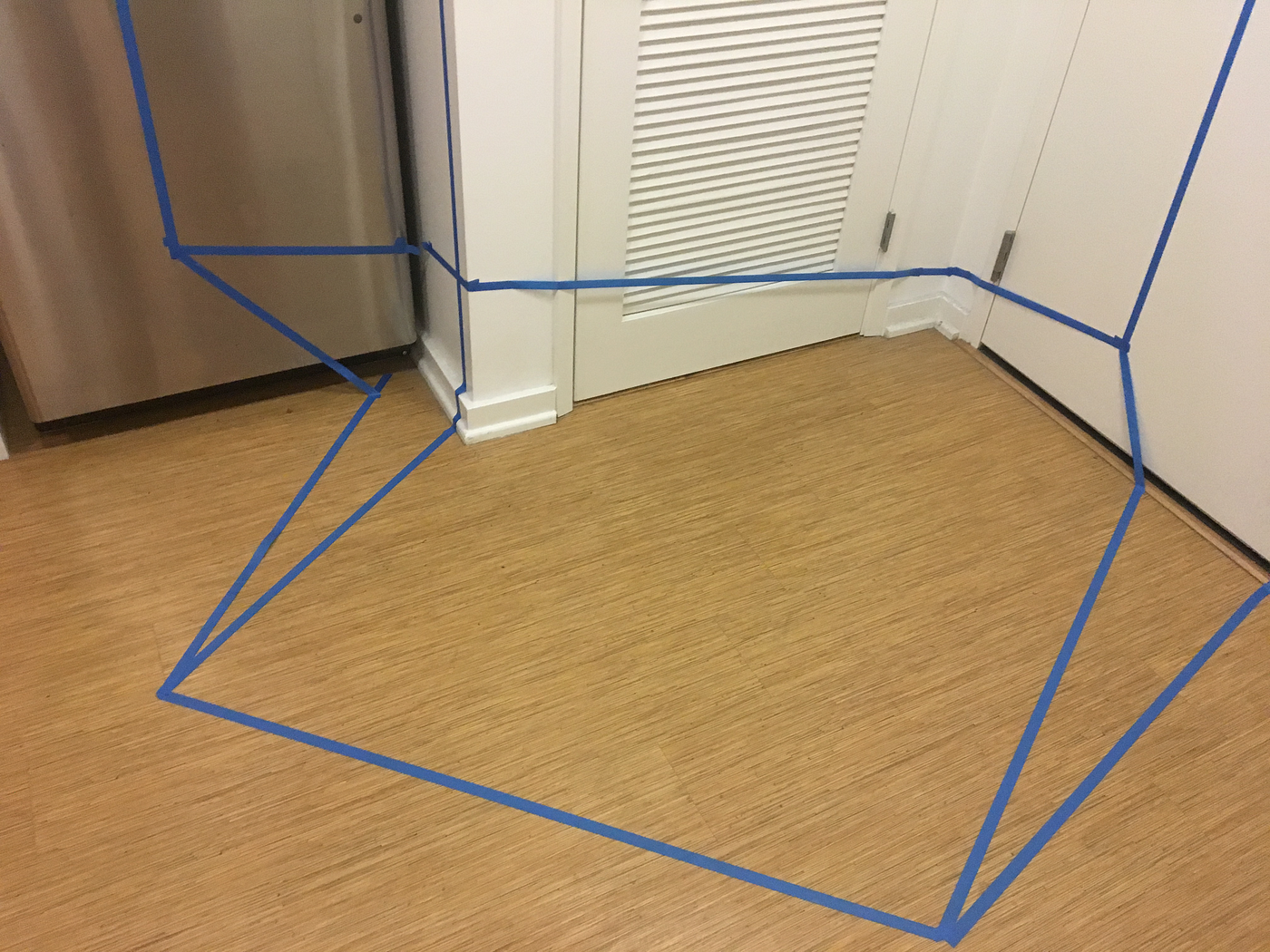
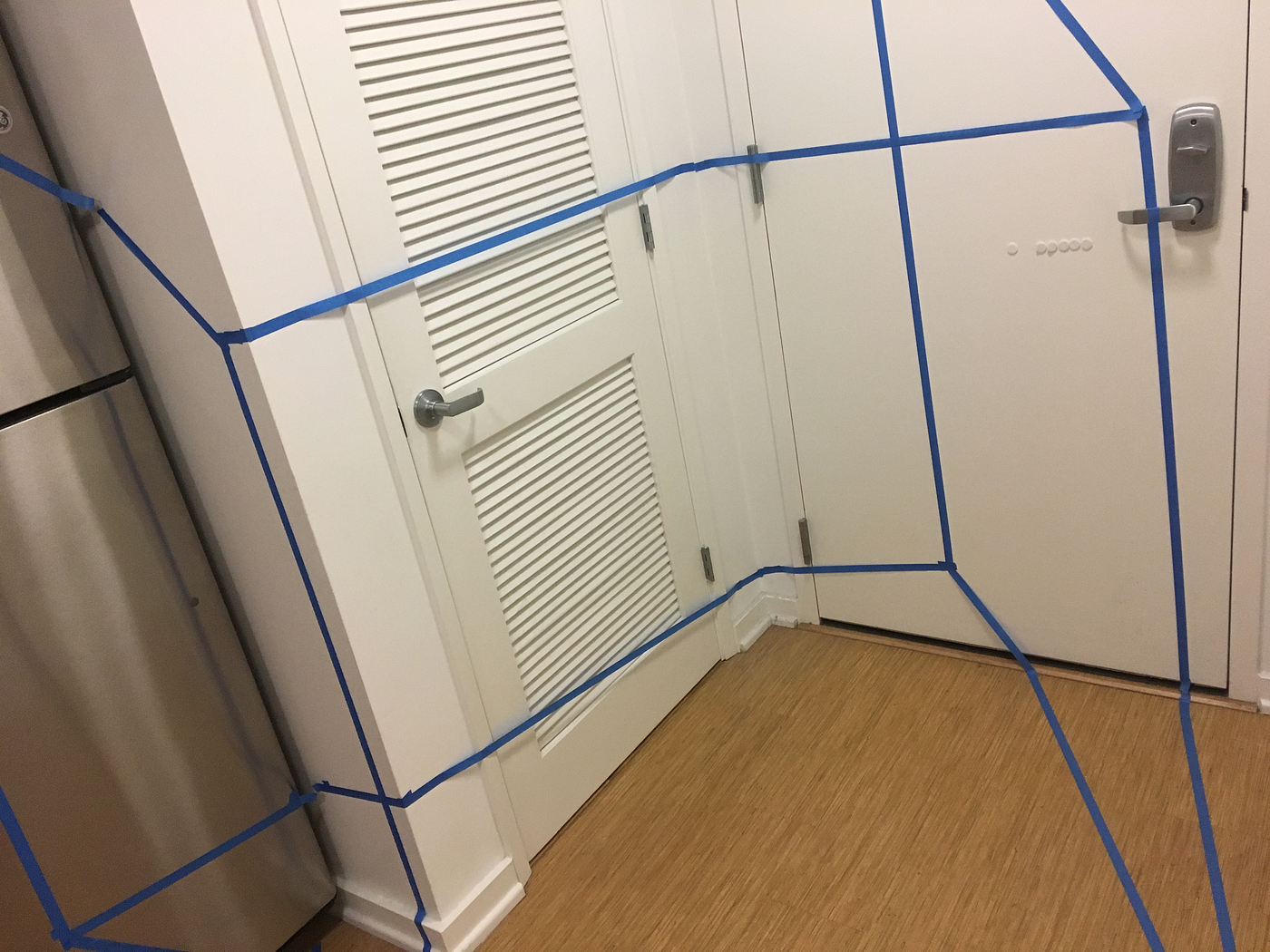
And here'southward a timelapse of the creation procedure:
That's it for today.

Since this month is nearly over, I decided to become through my practice log today and tally upwardly the fourth dimension I spent on the Rubik's Cube challenge. Here's what I institute…
In Jan, I solved the Rubik's Cube 907 times. For each recorded solve, I averaged 25.4 seconds solving, 15 seconds scrambling, and 15 seconds inspecting. This equates to well-nigh 14 hours.
I likewise spent another 5 hours learning new Rubik's Cube algorithms, and another 3 hours completing other training exercises.
And then, in total, I spent 22 hours on this month's challenge. In other words, every hour I expert, I decreased my solve time by near iv%, which compounded quickly, until I executed a 17 2d solve.

Today is the last solar day of January, which means it's also the terminal day of "Rubik's Cube Month".
And while this project shifts its focus elsewhere, I certainly will continue cubing. There'southward just something about it that'due south so meditative. I get completely engrossed in it.
Sometimes, cubing enables the quiet the listen kind of meditation, merely, more usually, it gets my heed into that actively creative country typically reserved for hot showers.
Particularly now that I've softened upward on my training, and instead, am relying on by and large automatically reflexes to solve the cube, I'k able to enter into that shower-like trance often. It's a great feeling to control.
Of class, everyone's experience with the Rubik's Cube is different, and if yous're interested in learning more about the perspectives and stories of other speed cubers, I'd recommend checking out the book Bang-up the Cube .
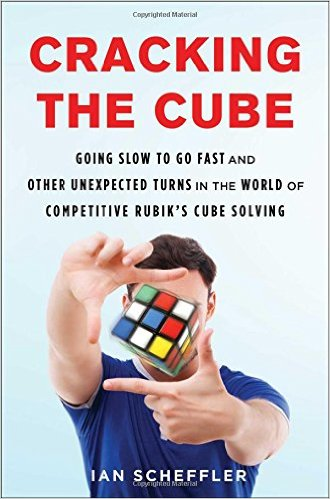
In the volume, writer Ian Scheffler integrates himself into the competitive world of speed cubing, sharing amusing stories near cubing'south main characters and weaving in his own pursuit of trying to suspension the 20-second speed threshold (It took Ian about i.5 years to get his time from effectually fifty seconds to twenty seconds).
Ian likewise had the adventure to interview Erno Rubik for his book, the inventor of the cube, which is also an interesting story.
Anyhow, if y'all are still itching to learn more nigh the cube, this volume is probably the best place to keep. If not, tomorrow I commencement a new M2M challenge: Landing a standing backflip.

This post is part of my year-long accelerated learning project, Month to Master.
If you lot desire to follow along with my daily posts, brand certain to follow this Medium account.
For exclusive content on accelerated learning, subject area, and lifestyle design, subscribe to my once-in-a-while newsletter.
Source: https://medium.com/@maxdeutsch/my-month-long-quest-to-solve-a-rubiks-cube-in-under-20-seconds-2b2204282575
0 Response to "How Fast Can a Rubik's Cube Be Solved"
Postar um comentário